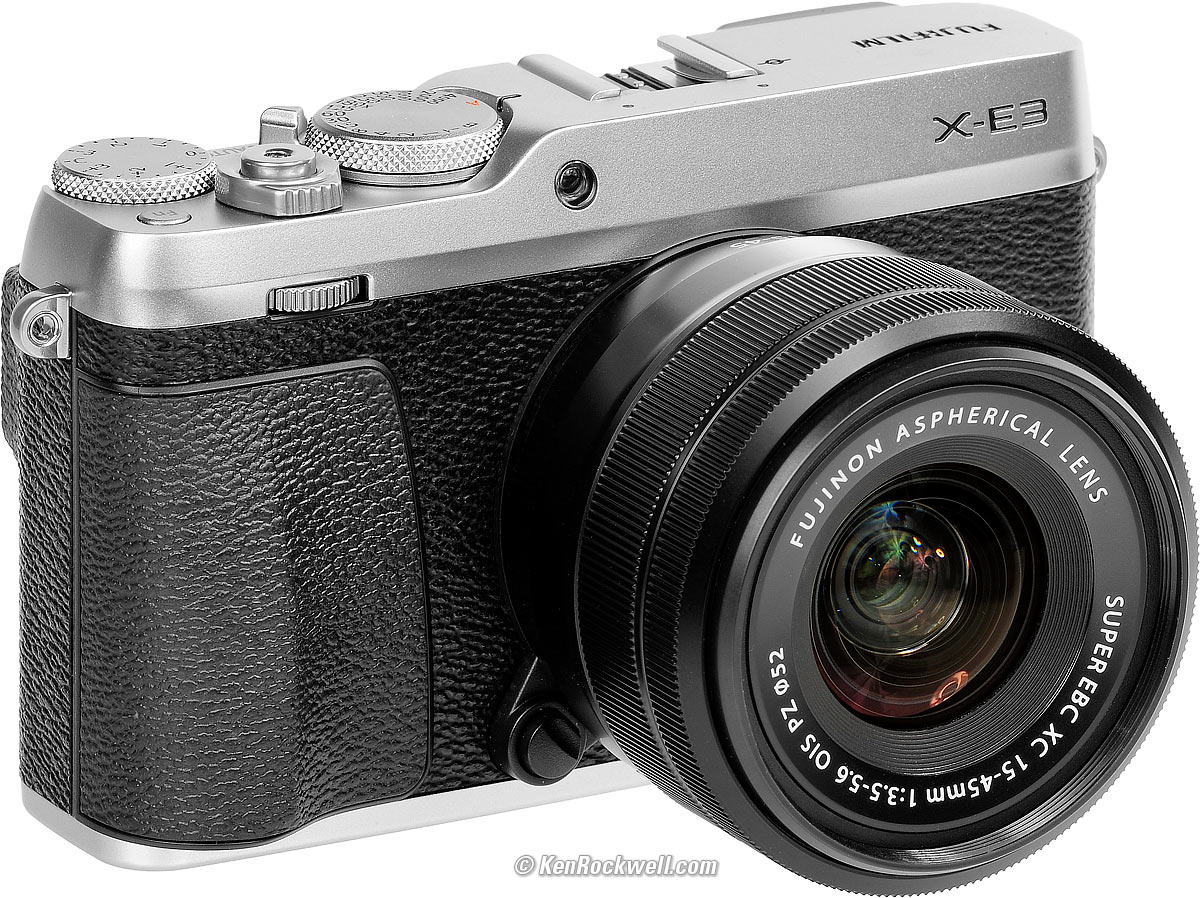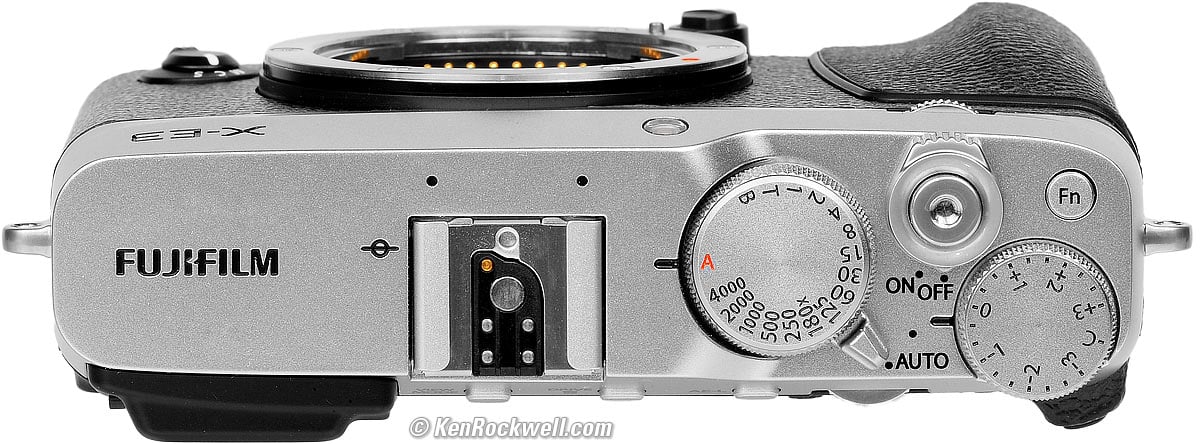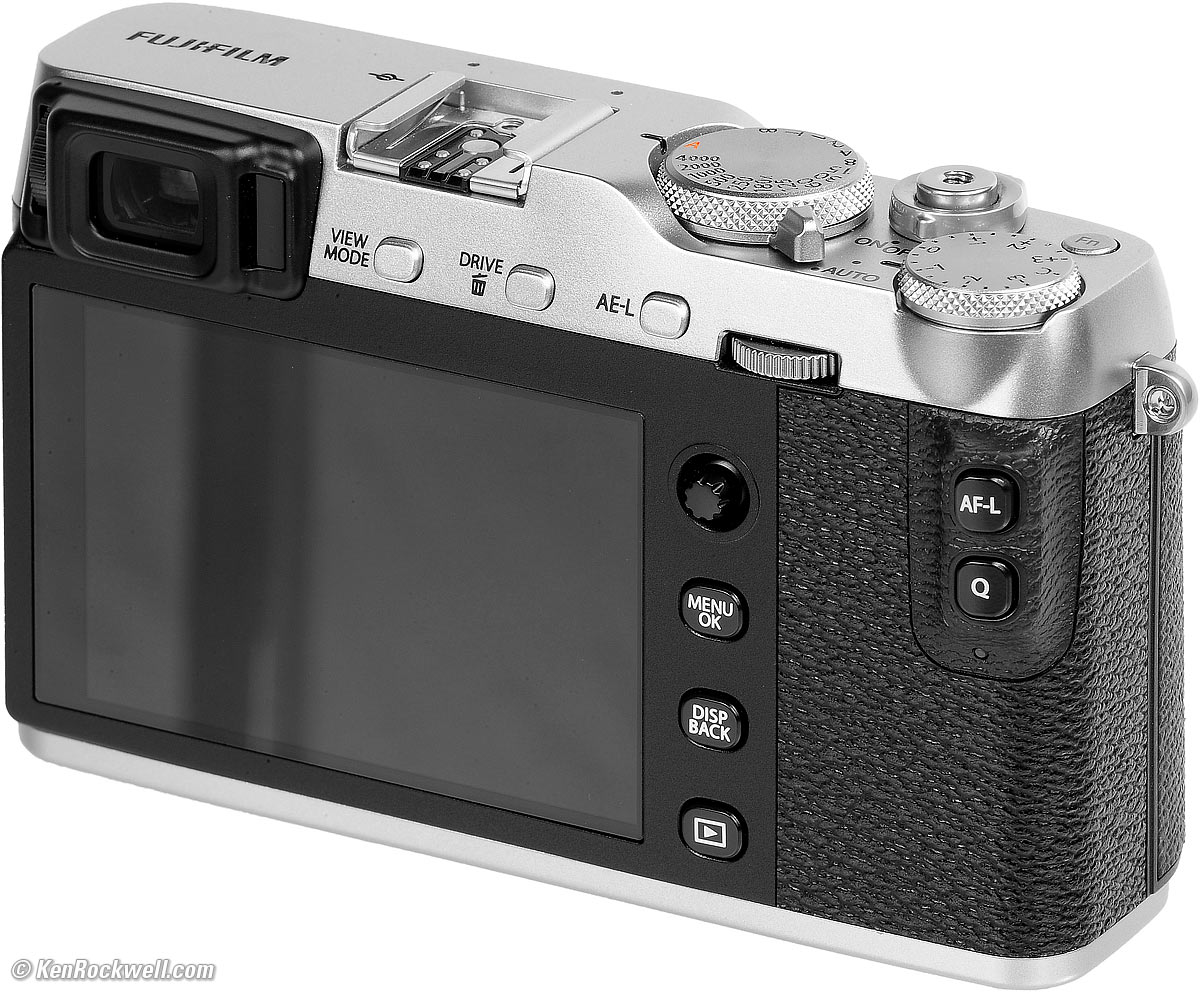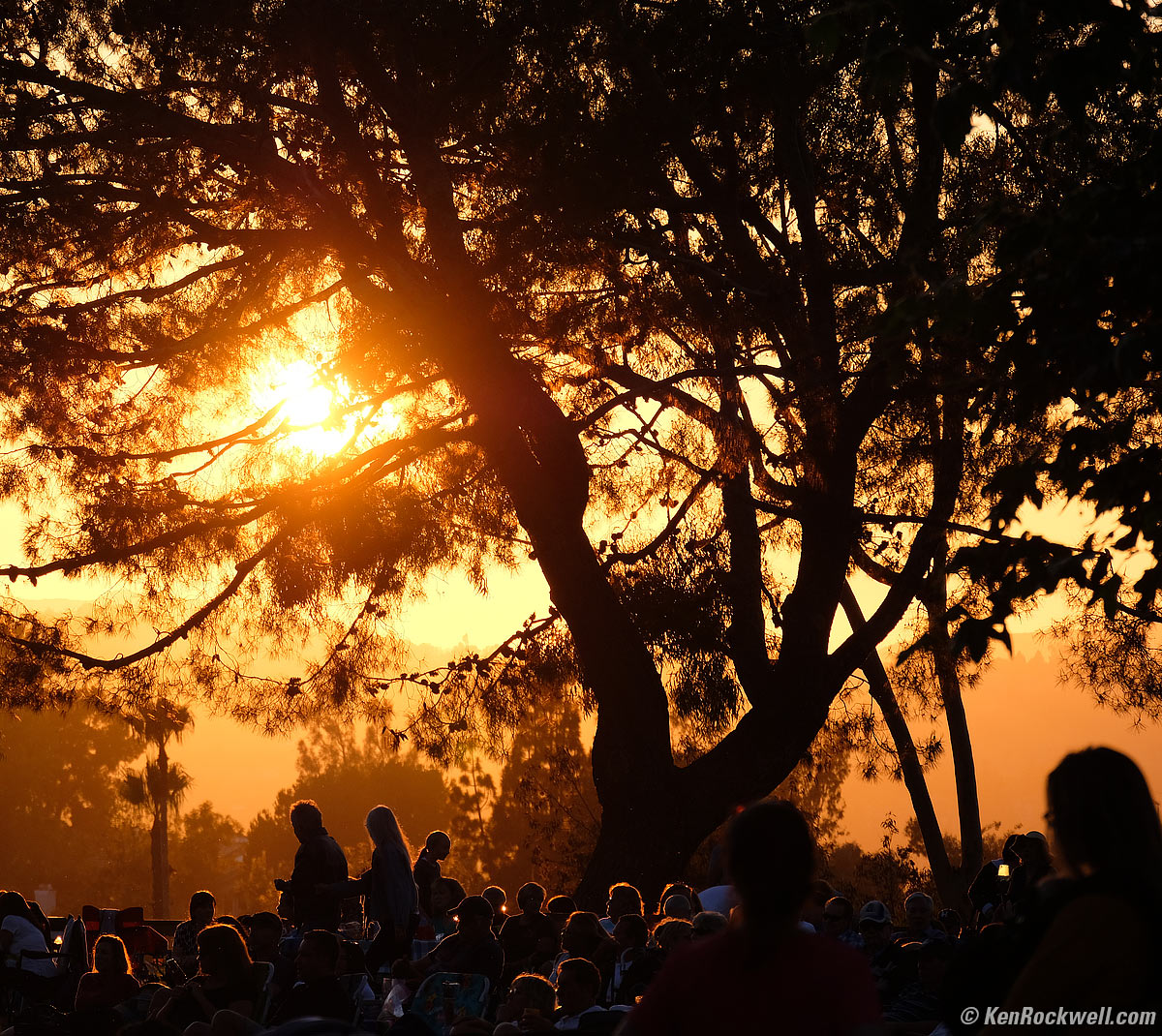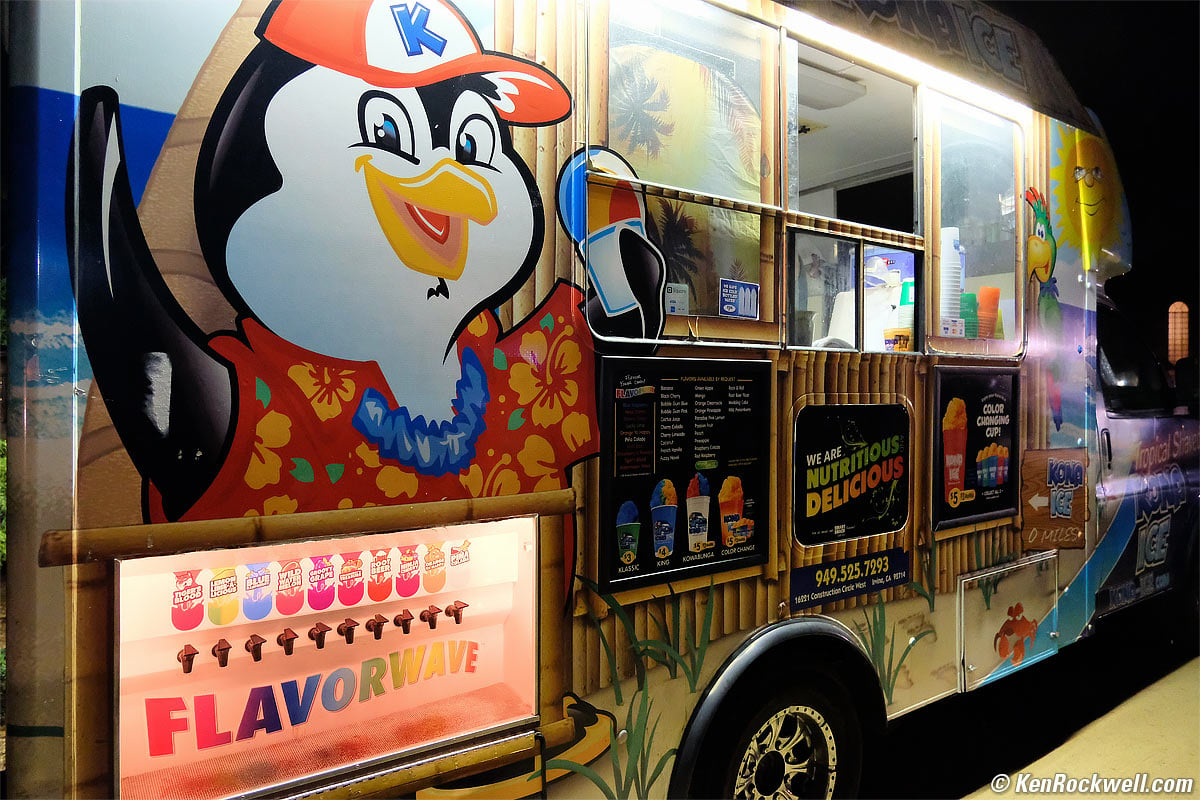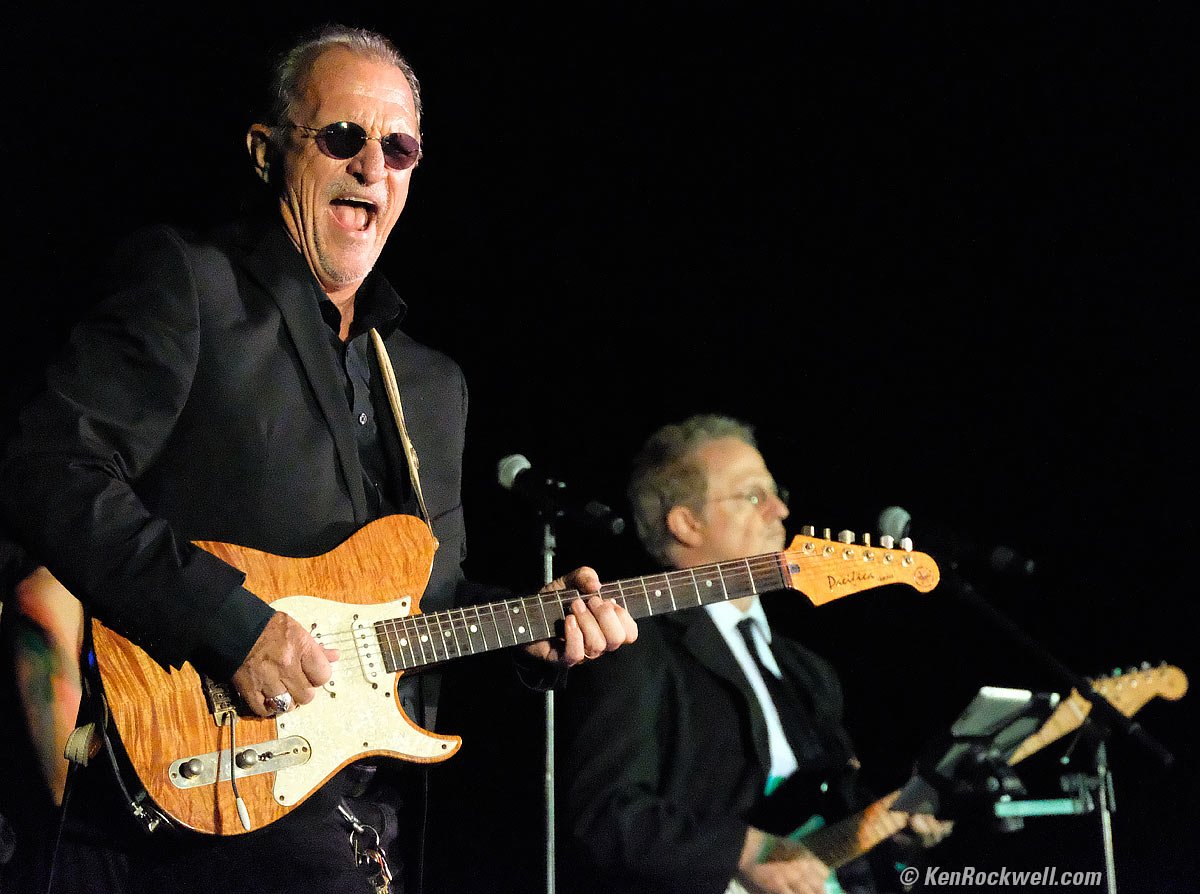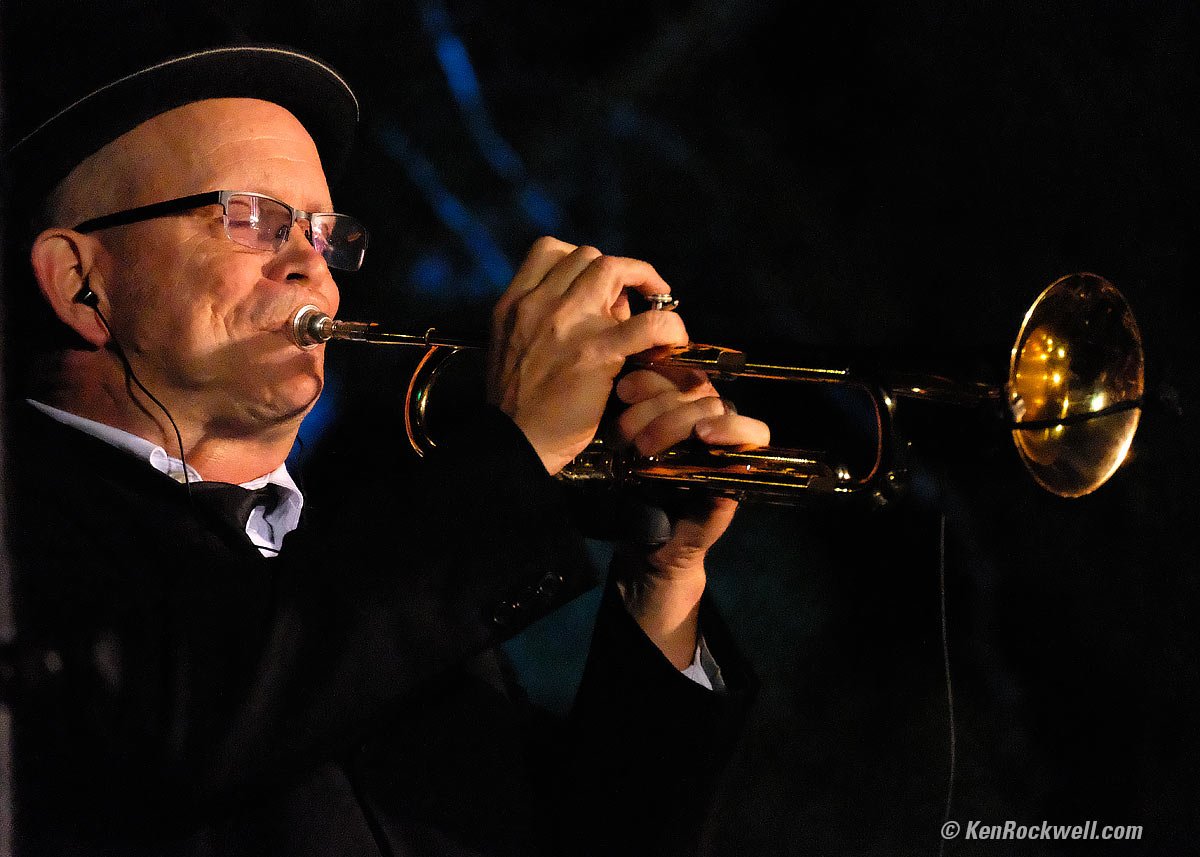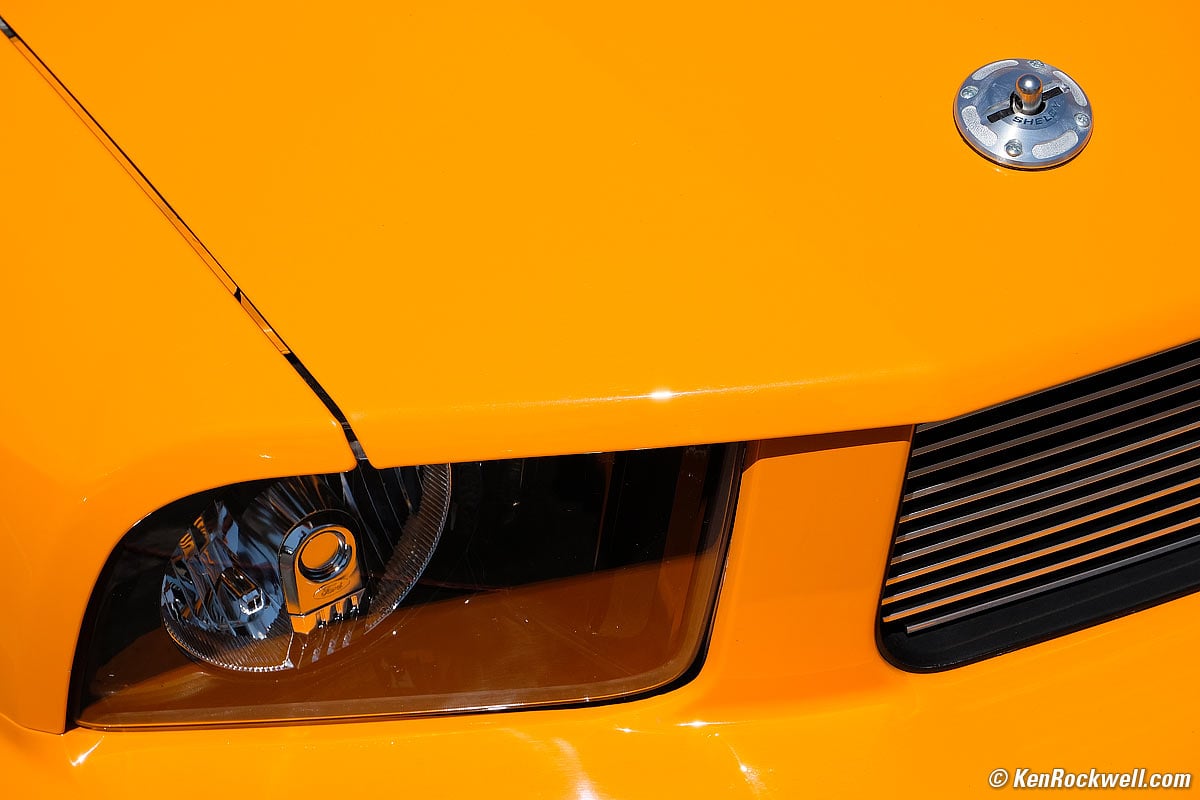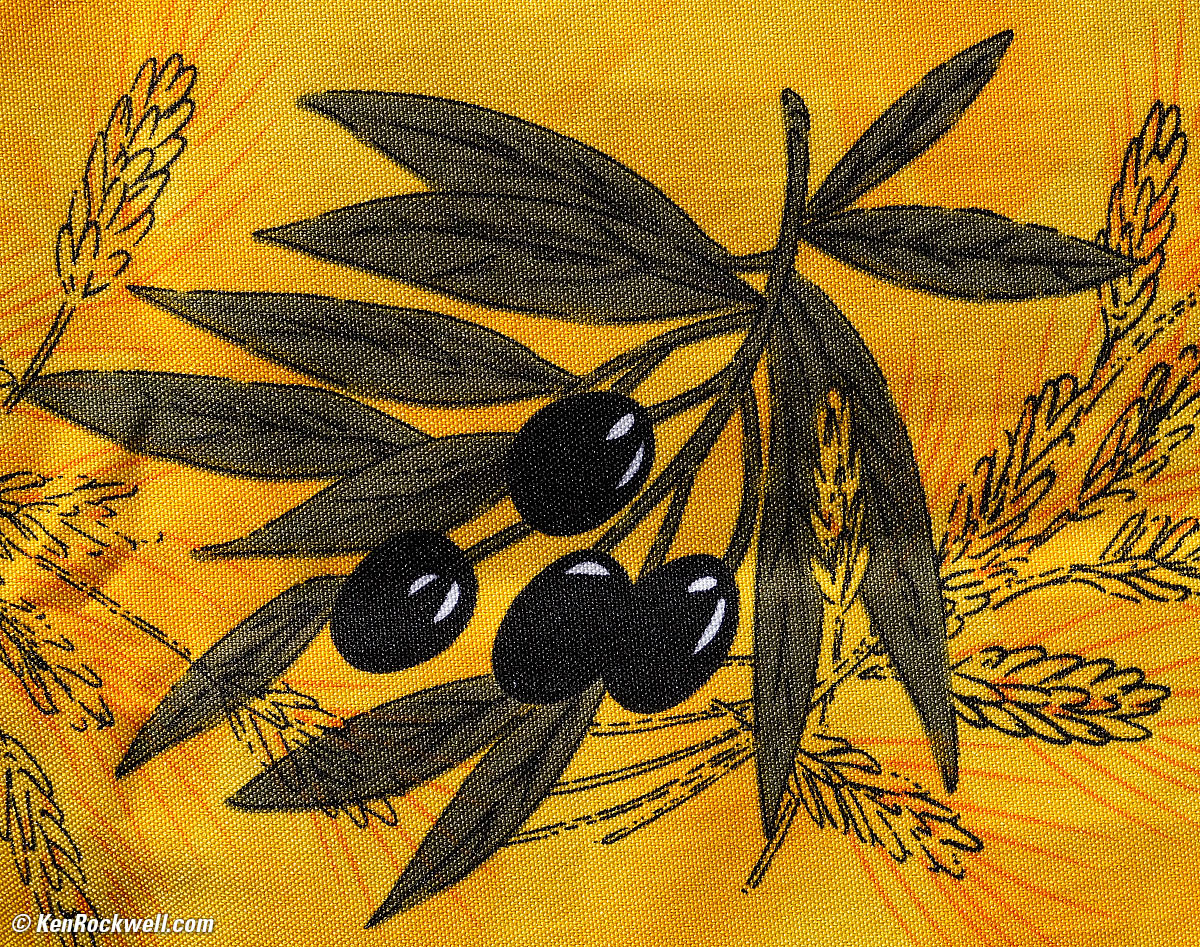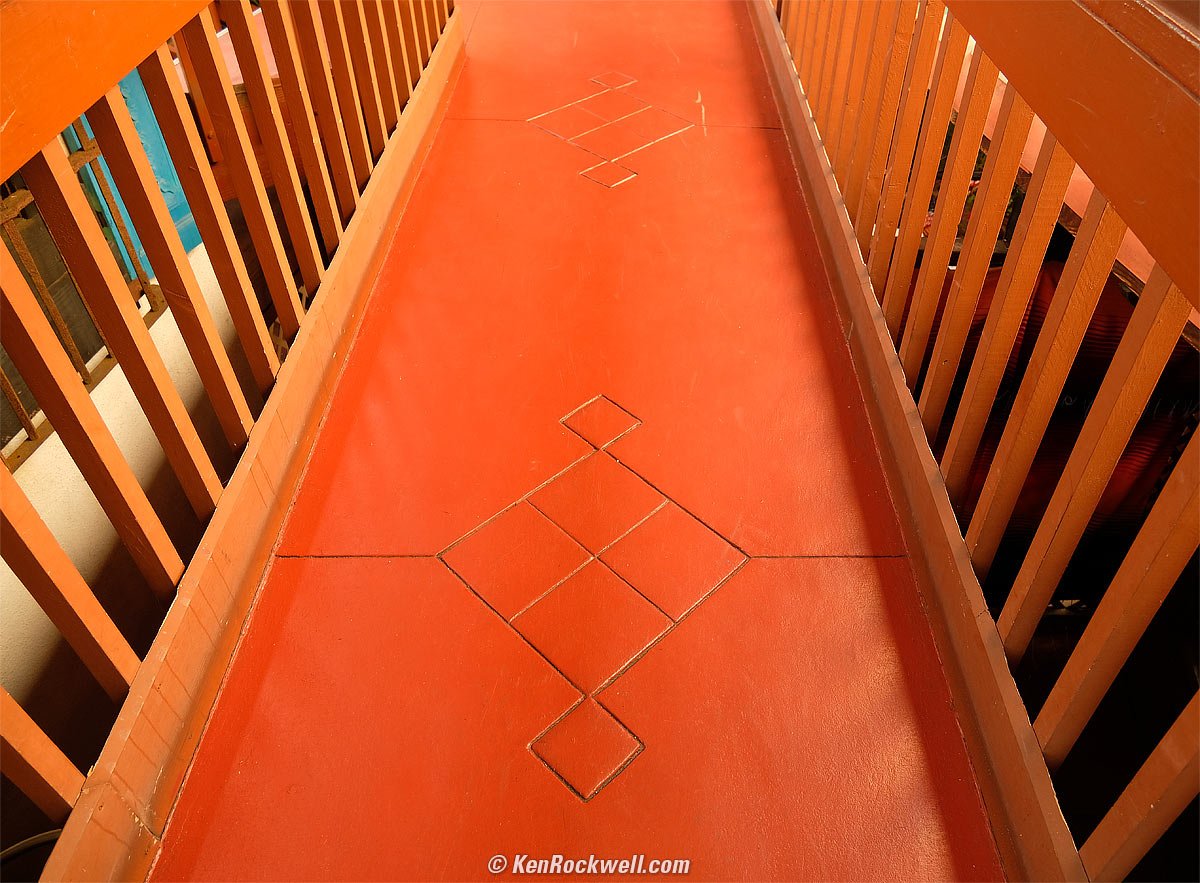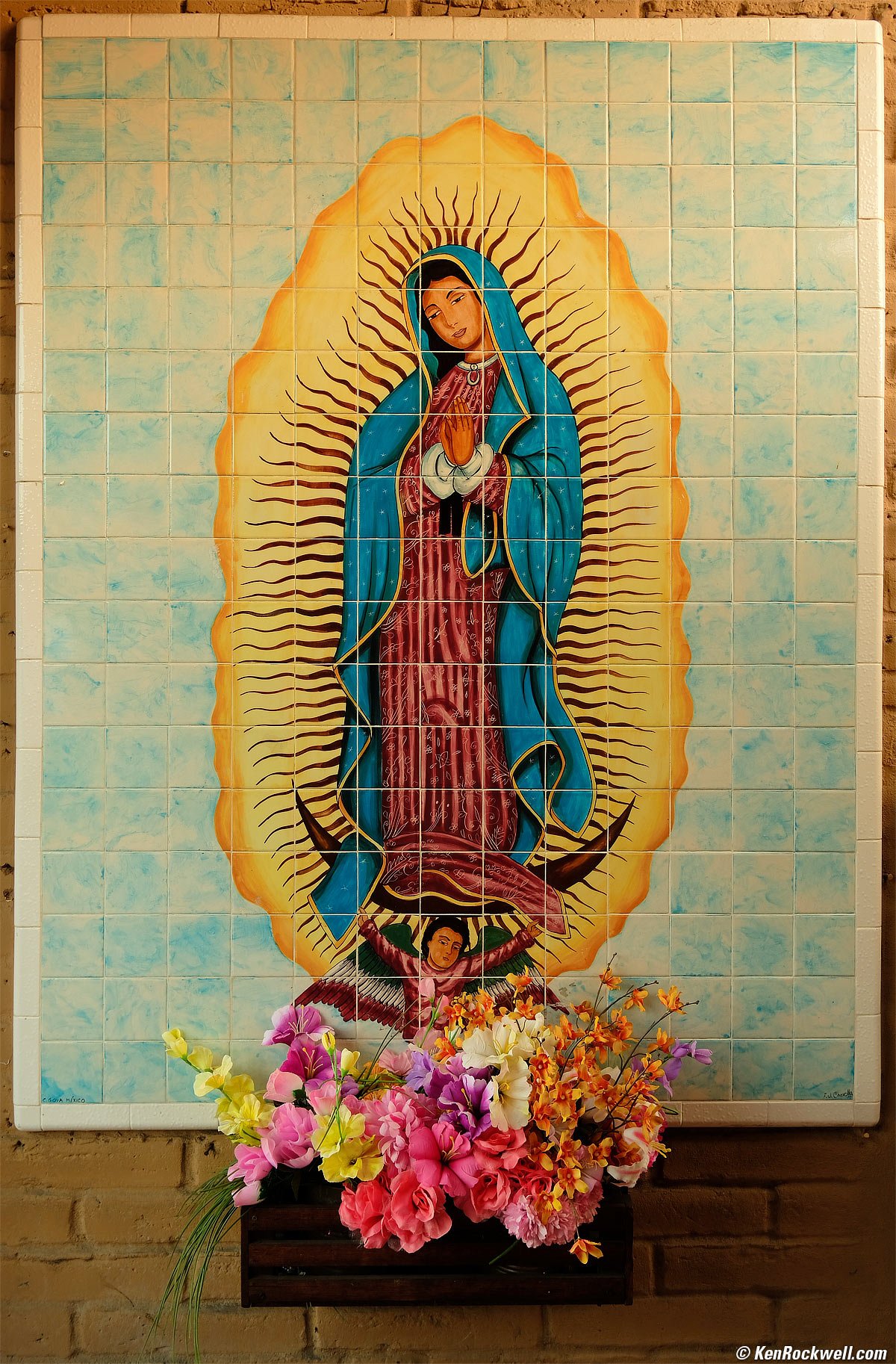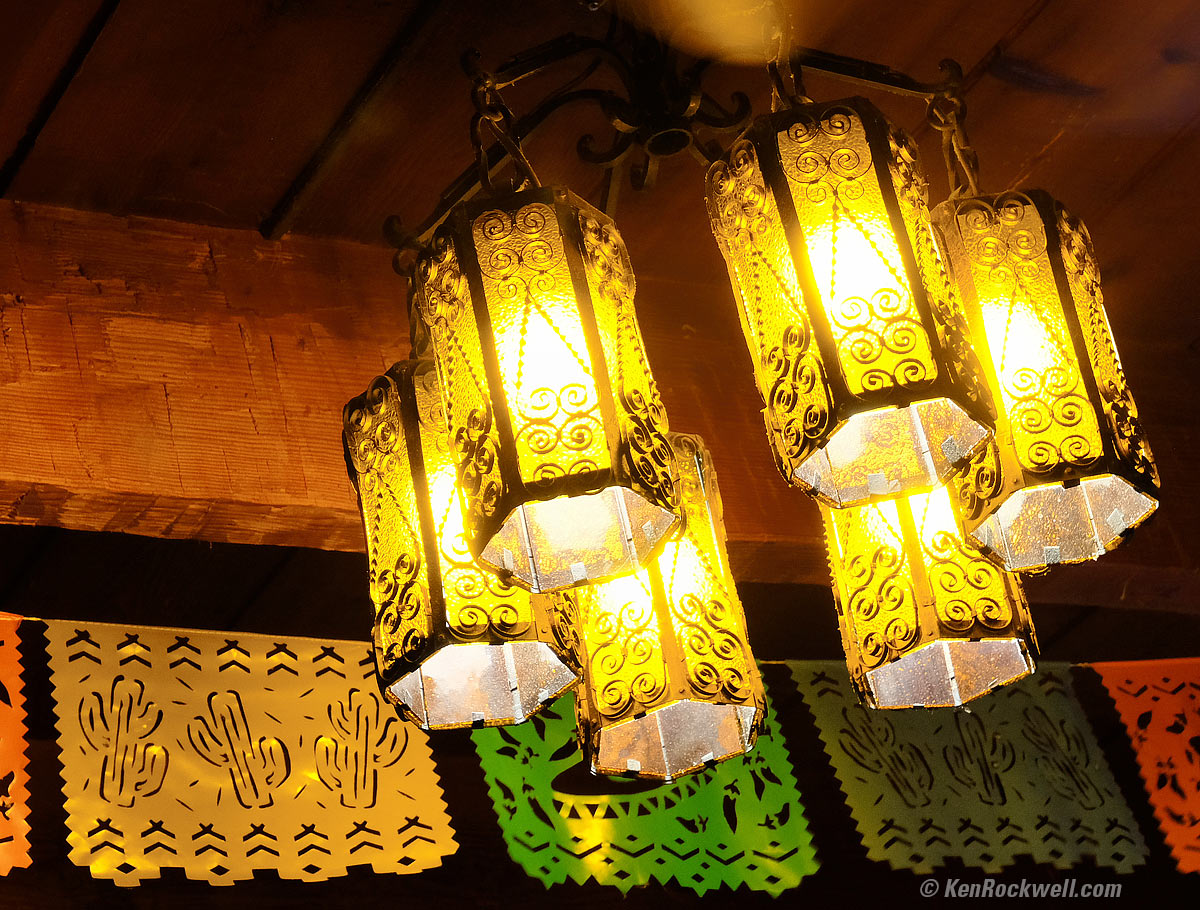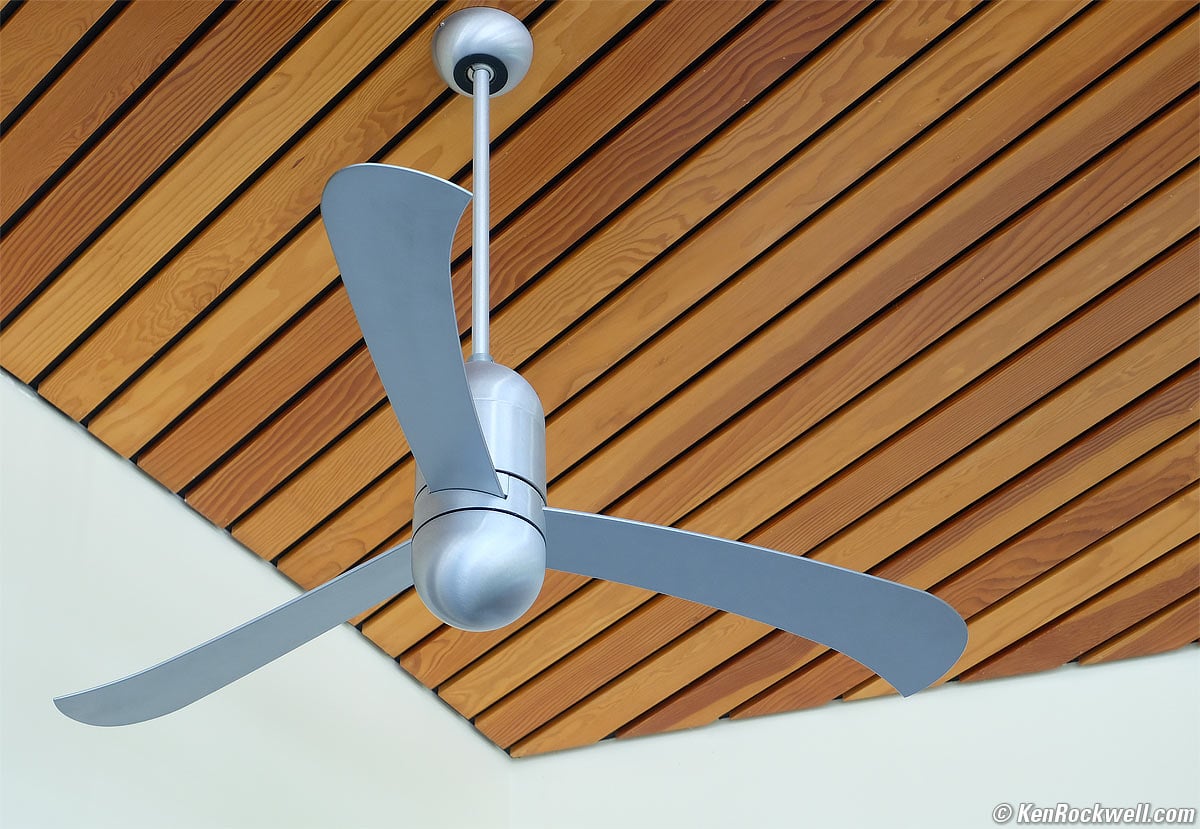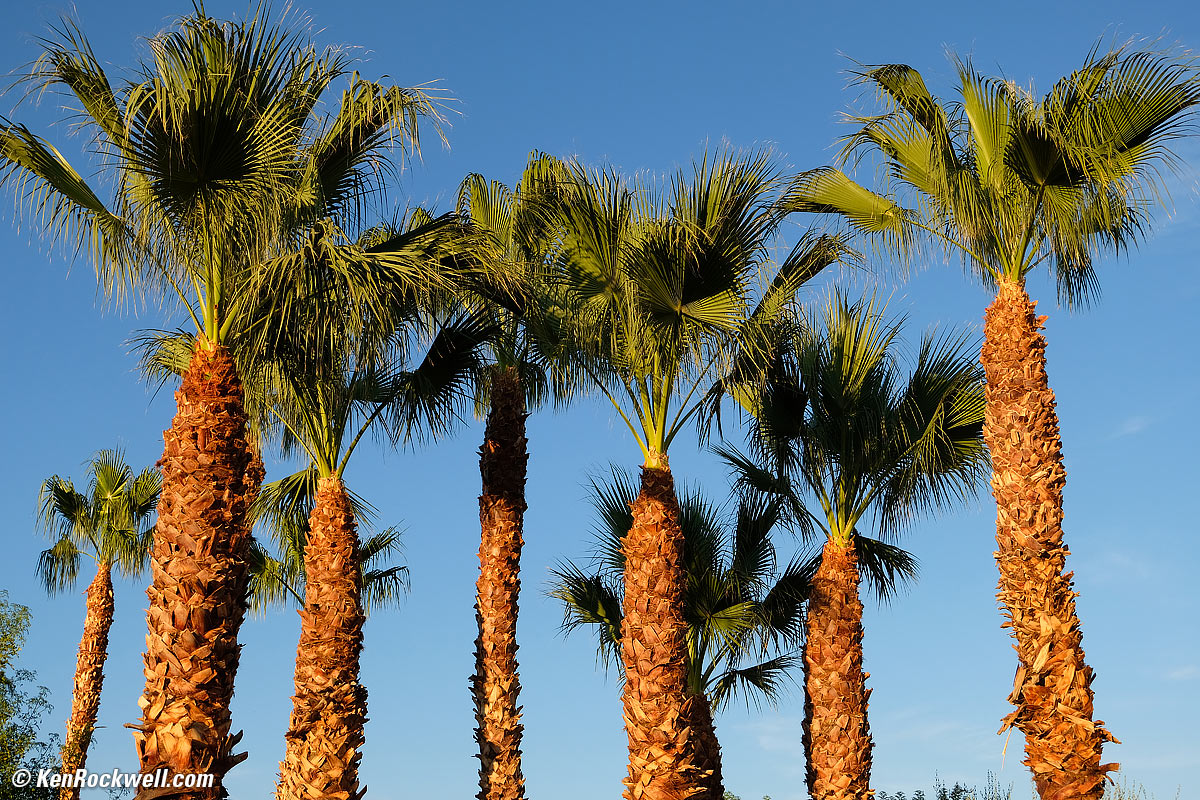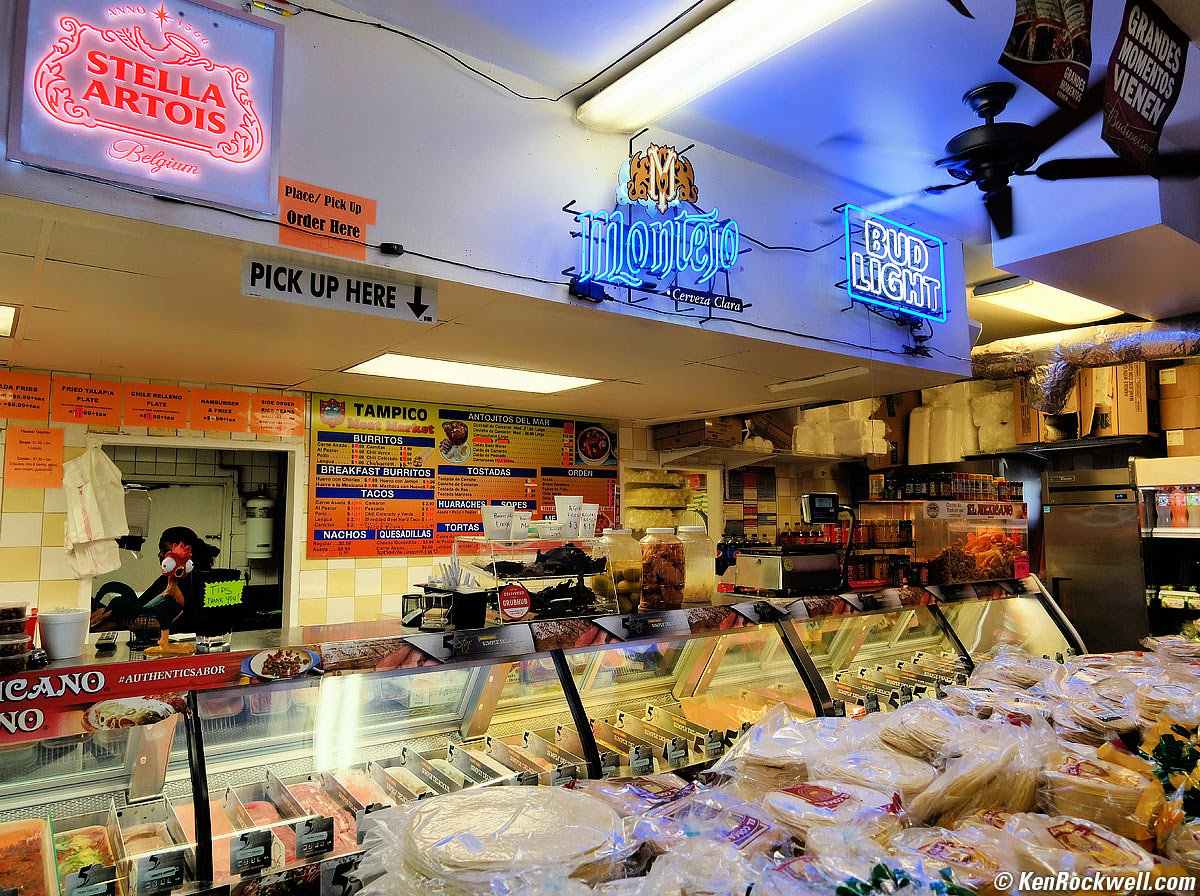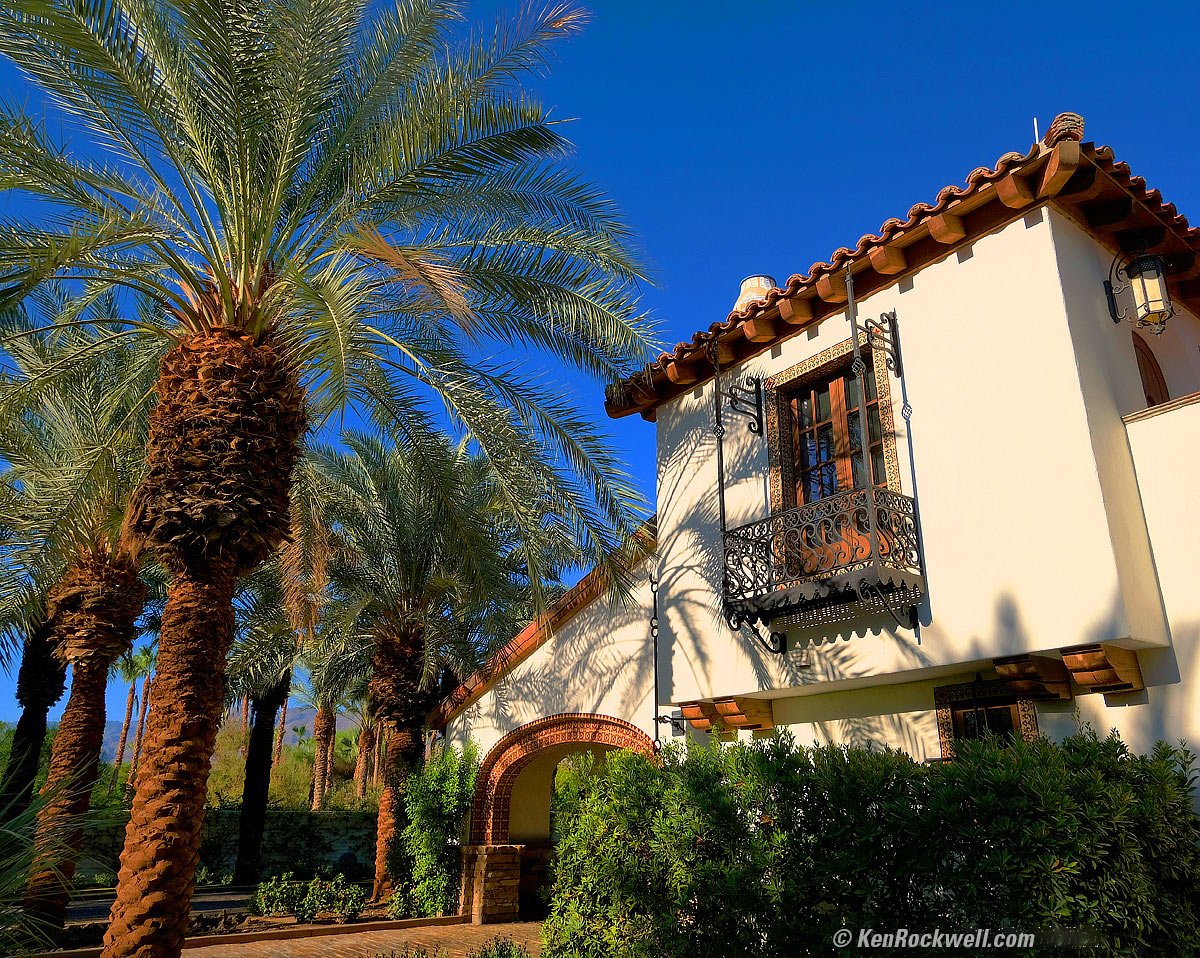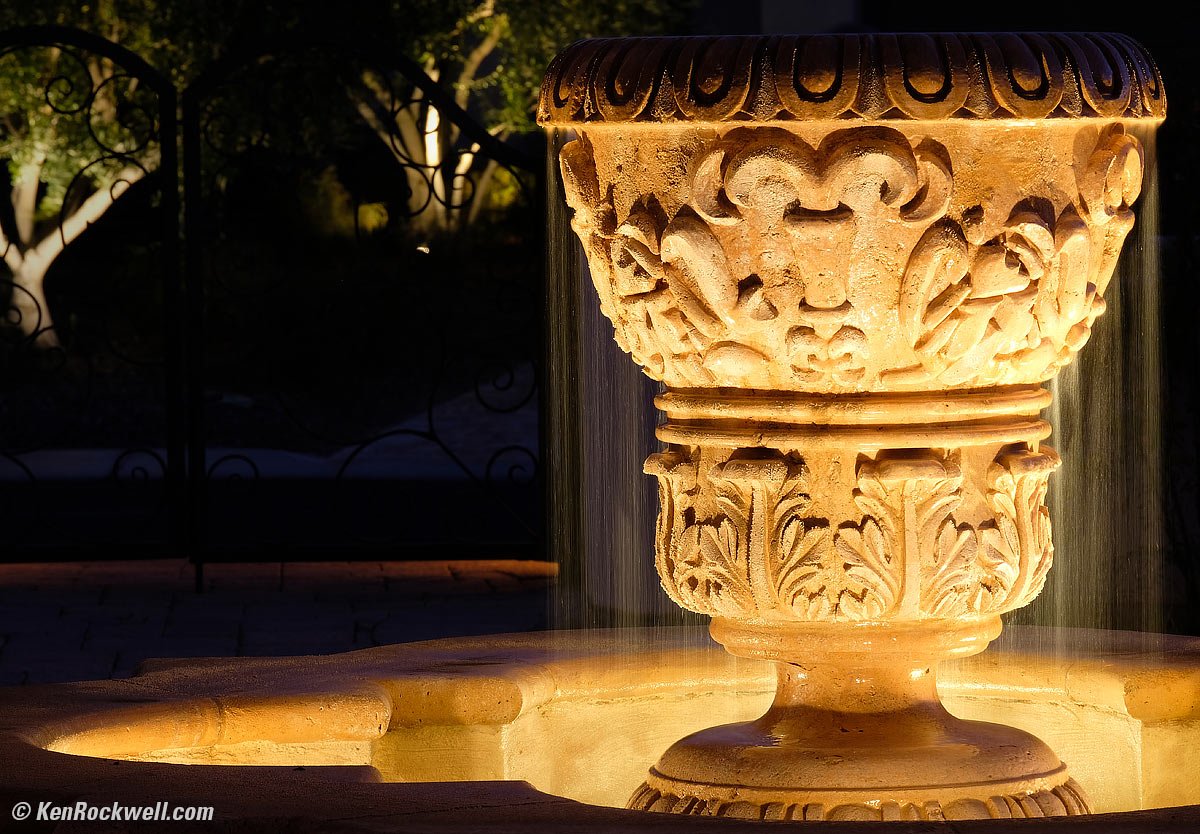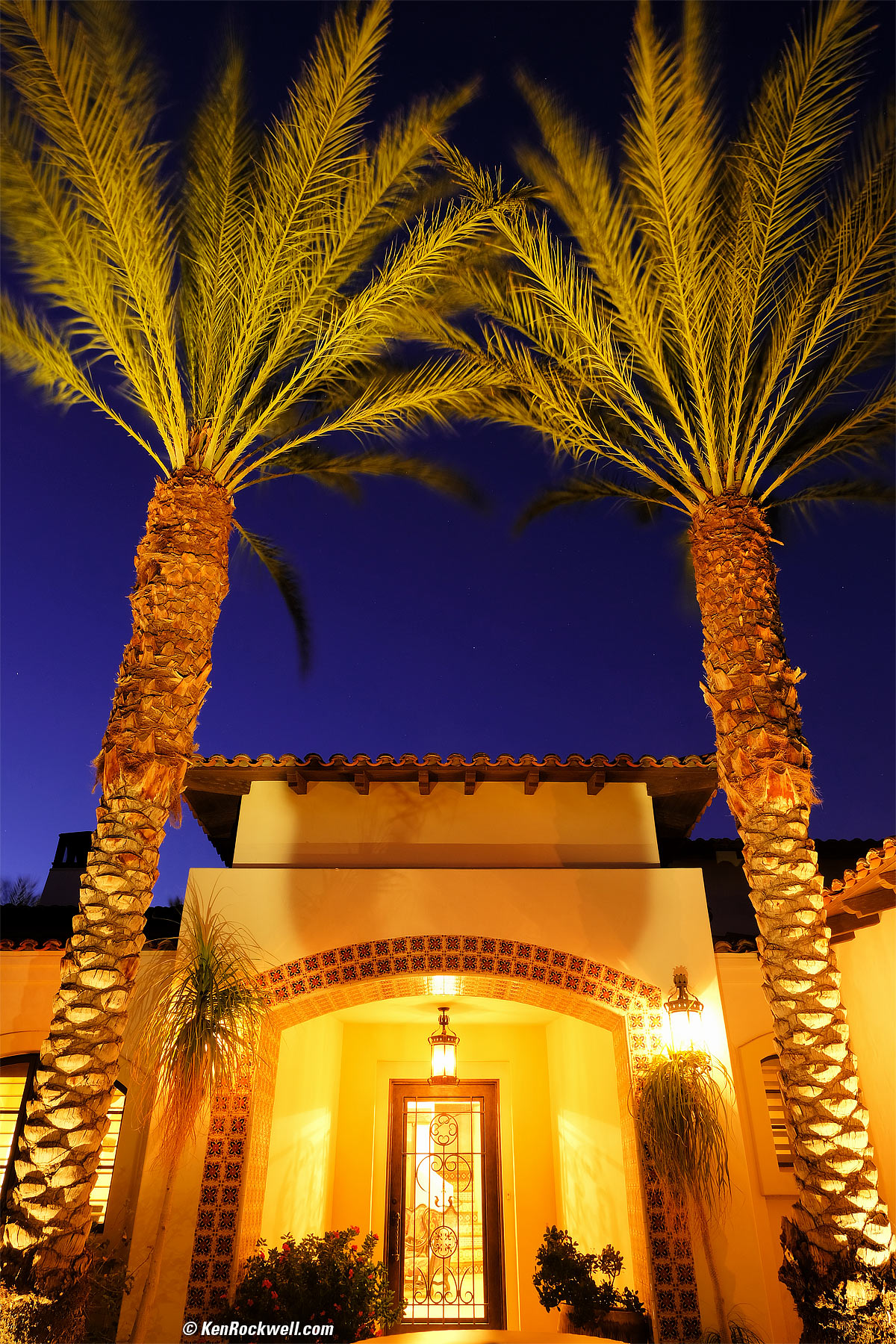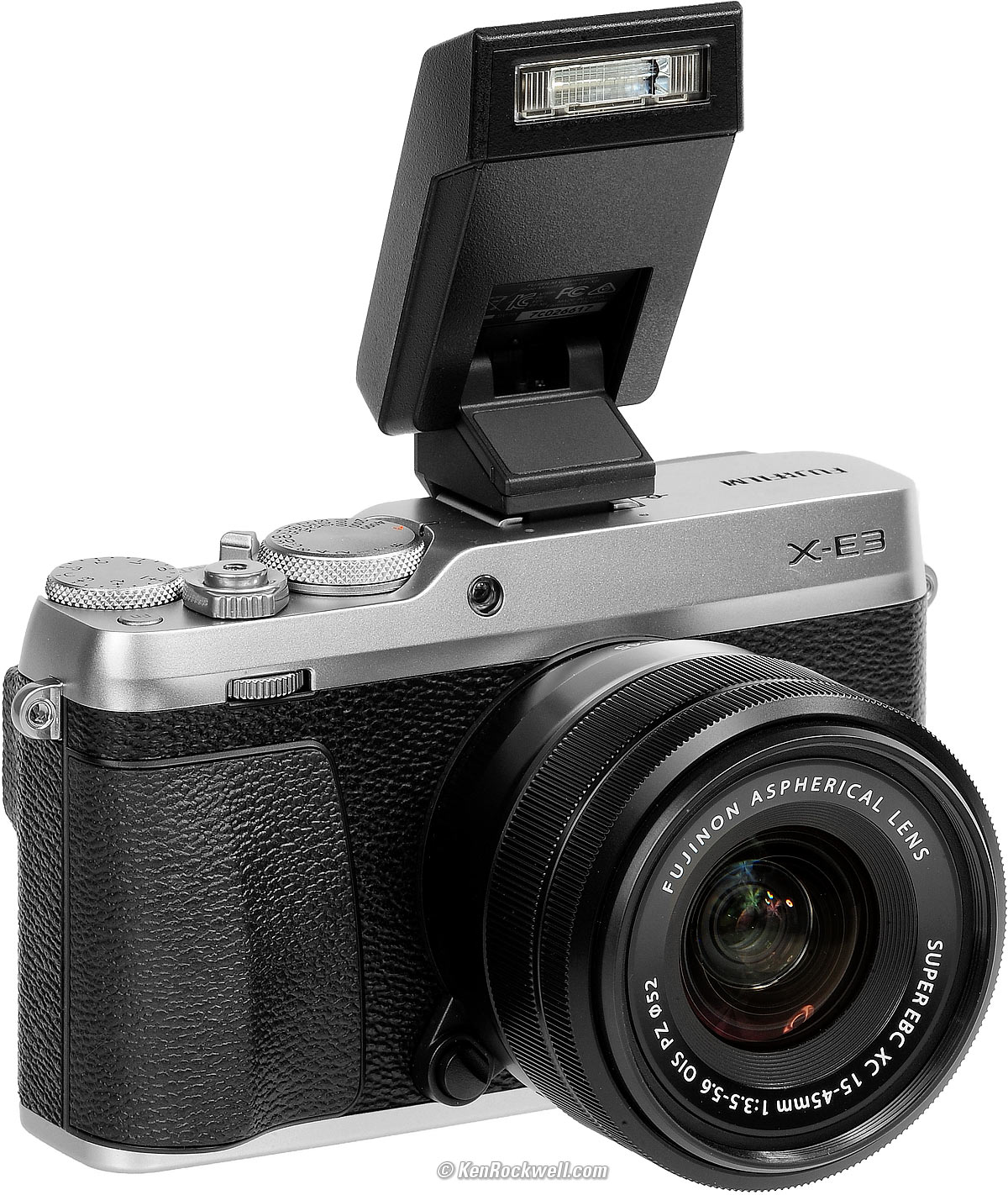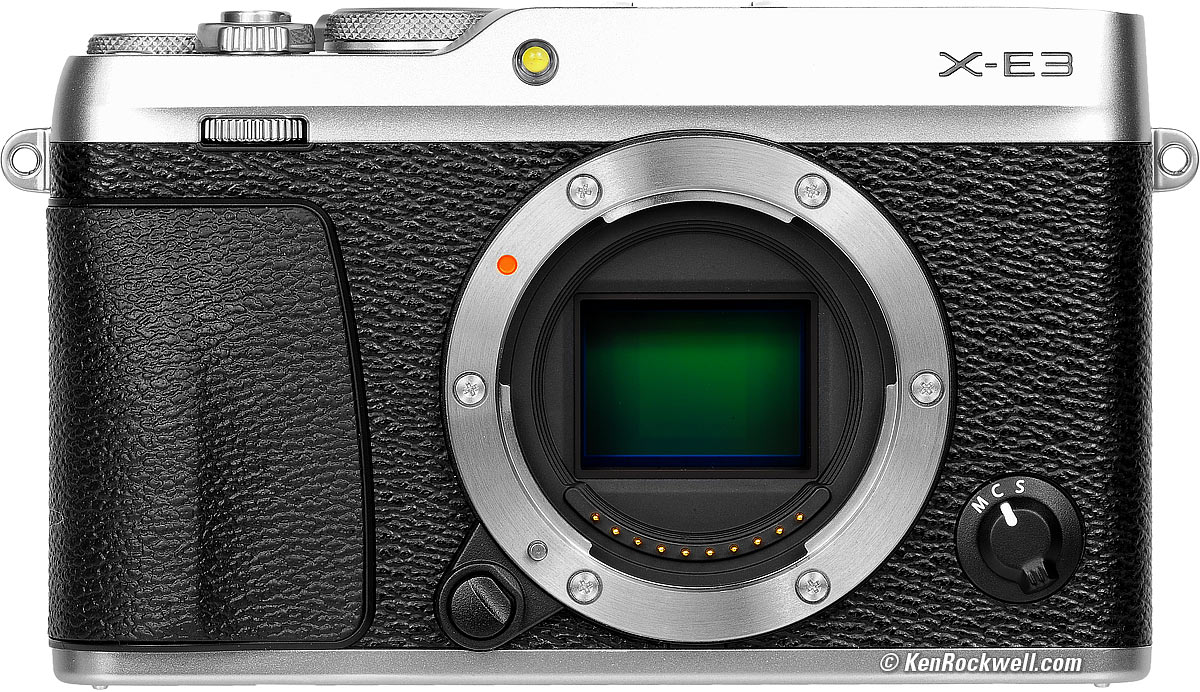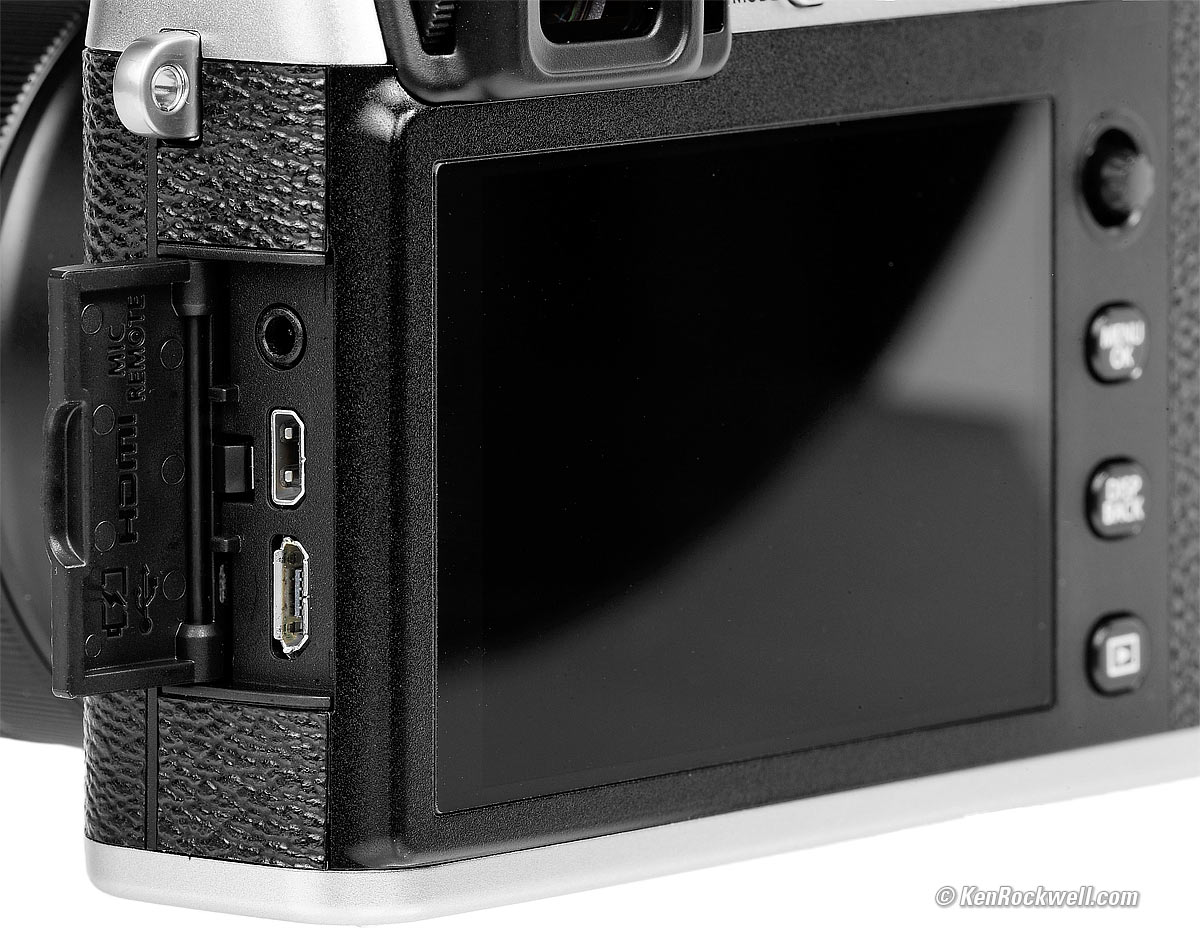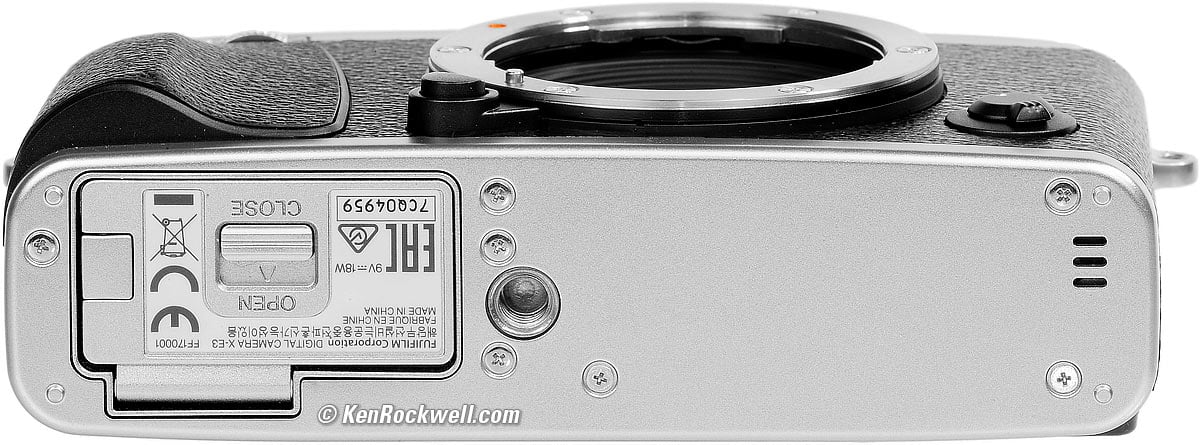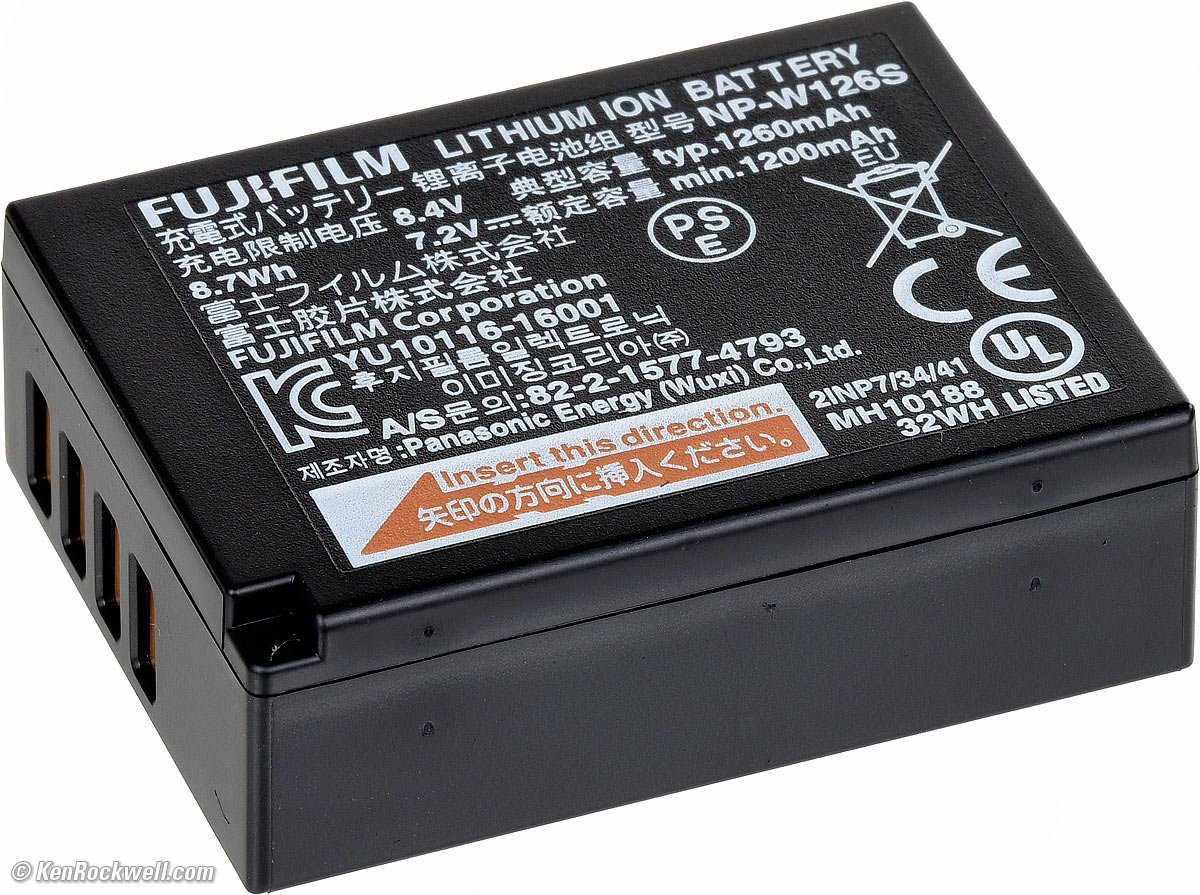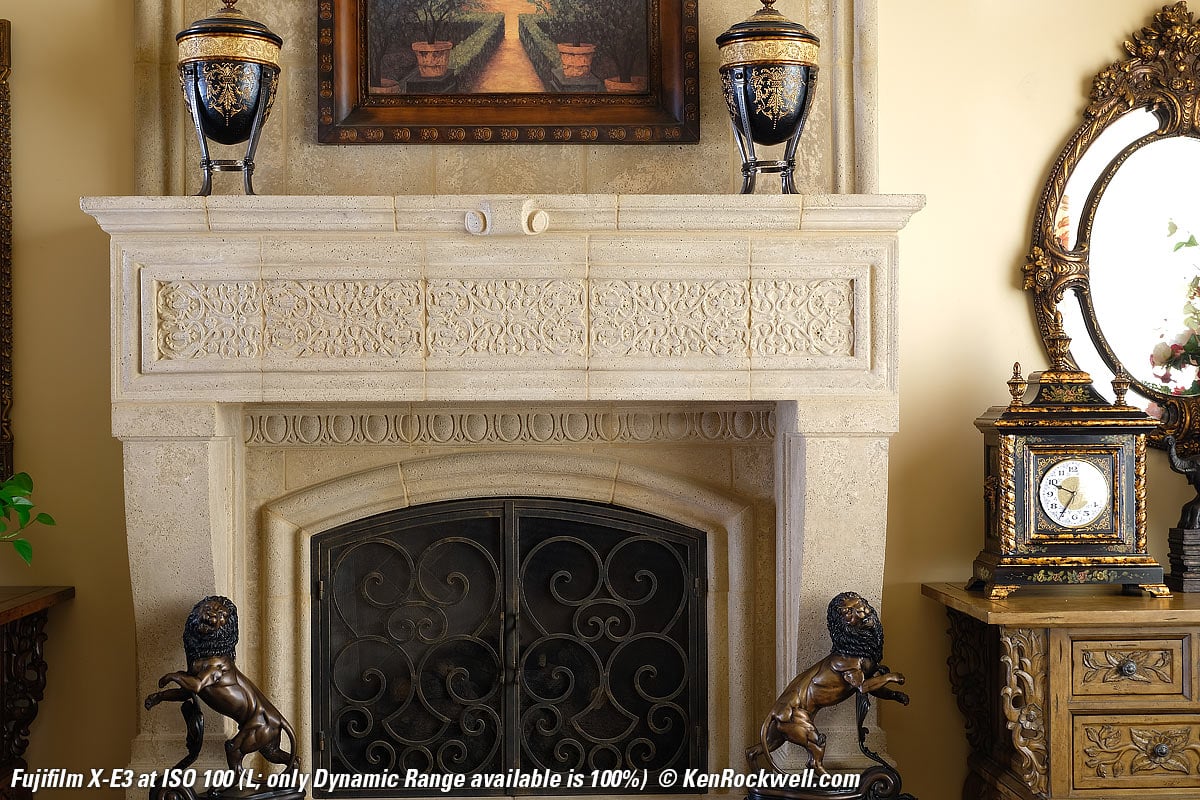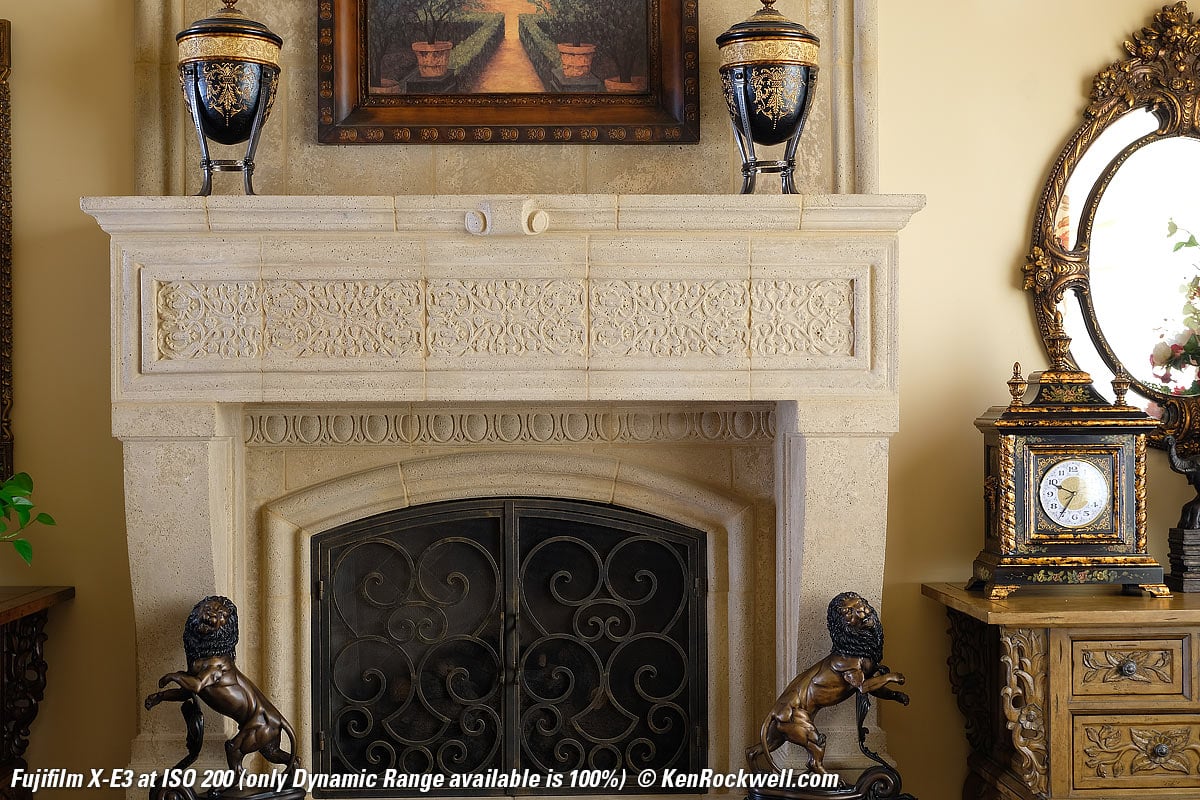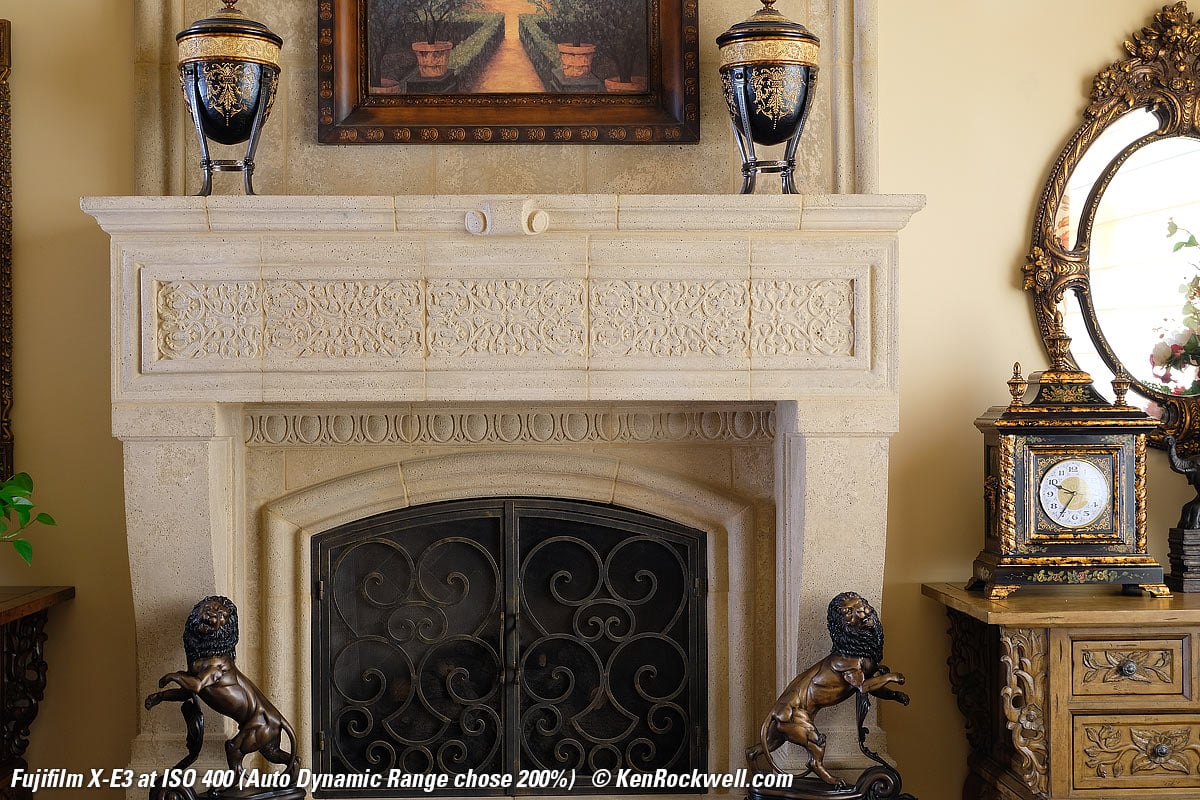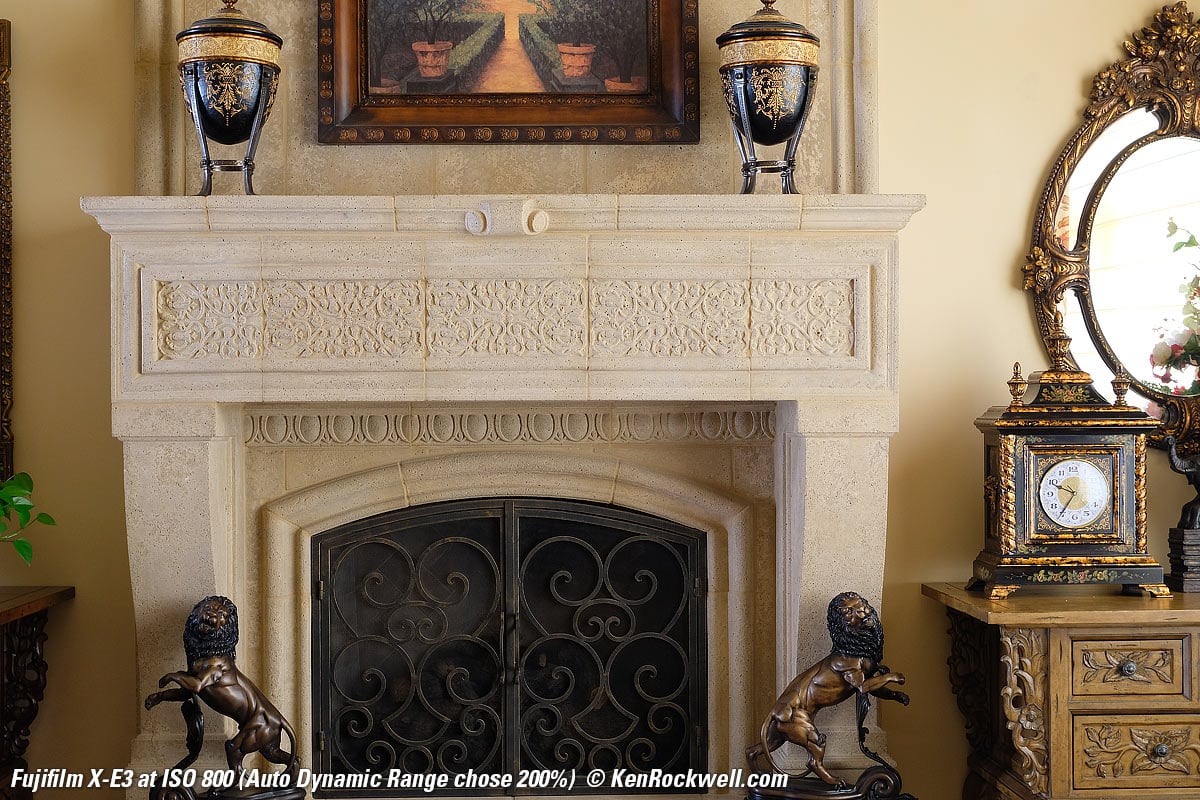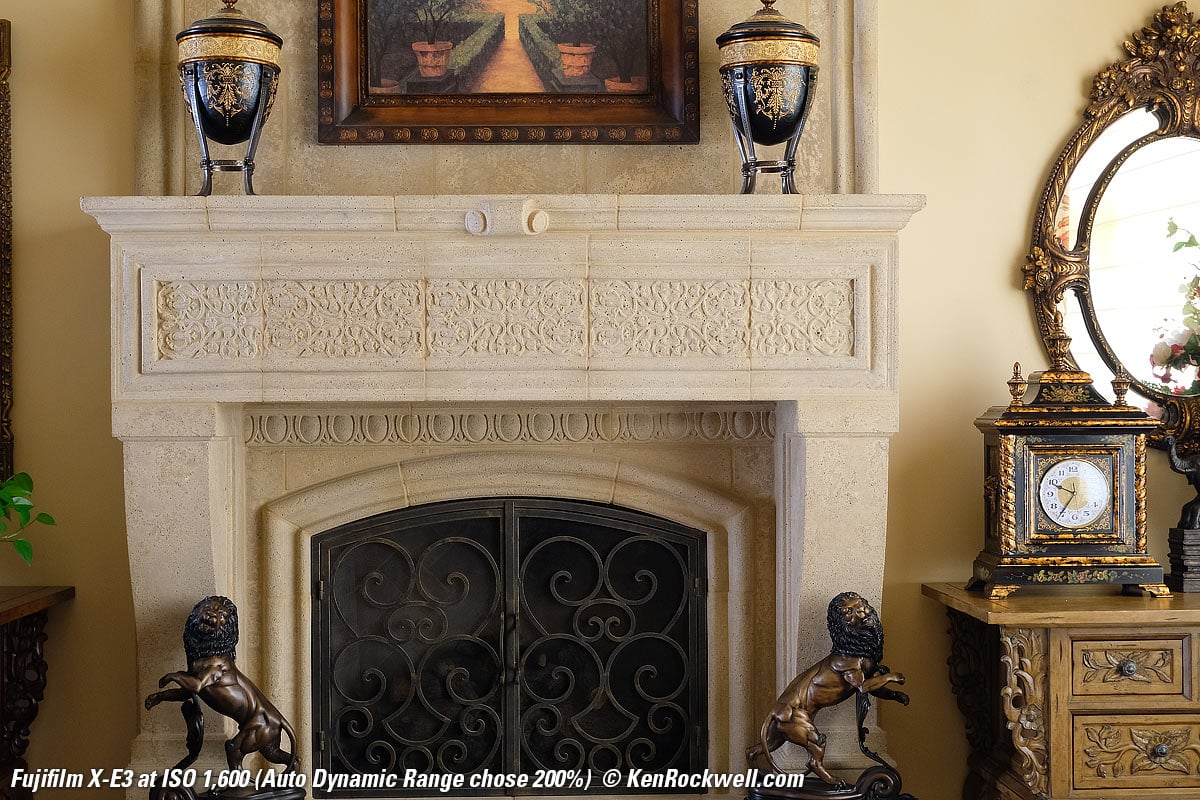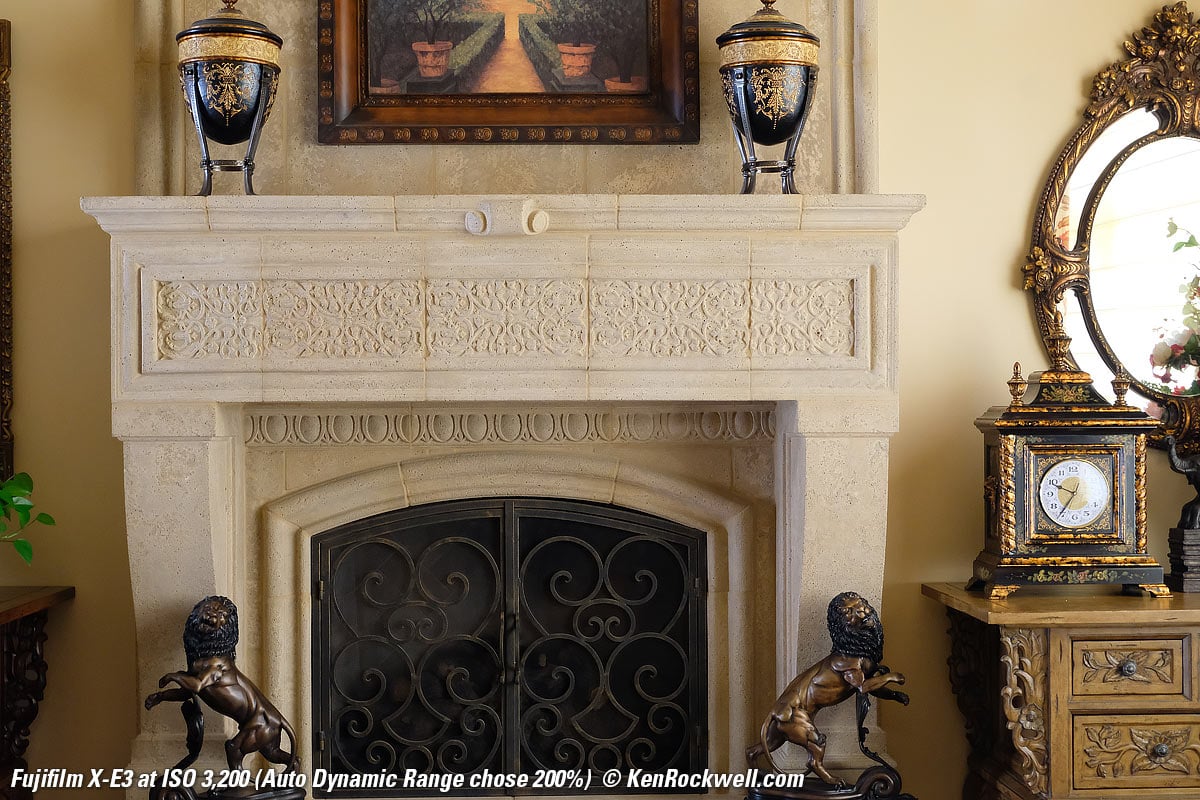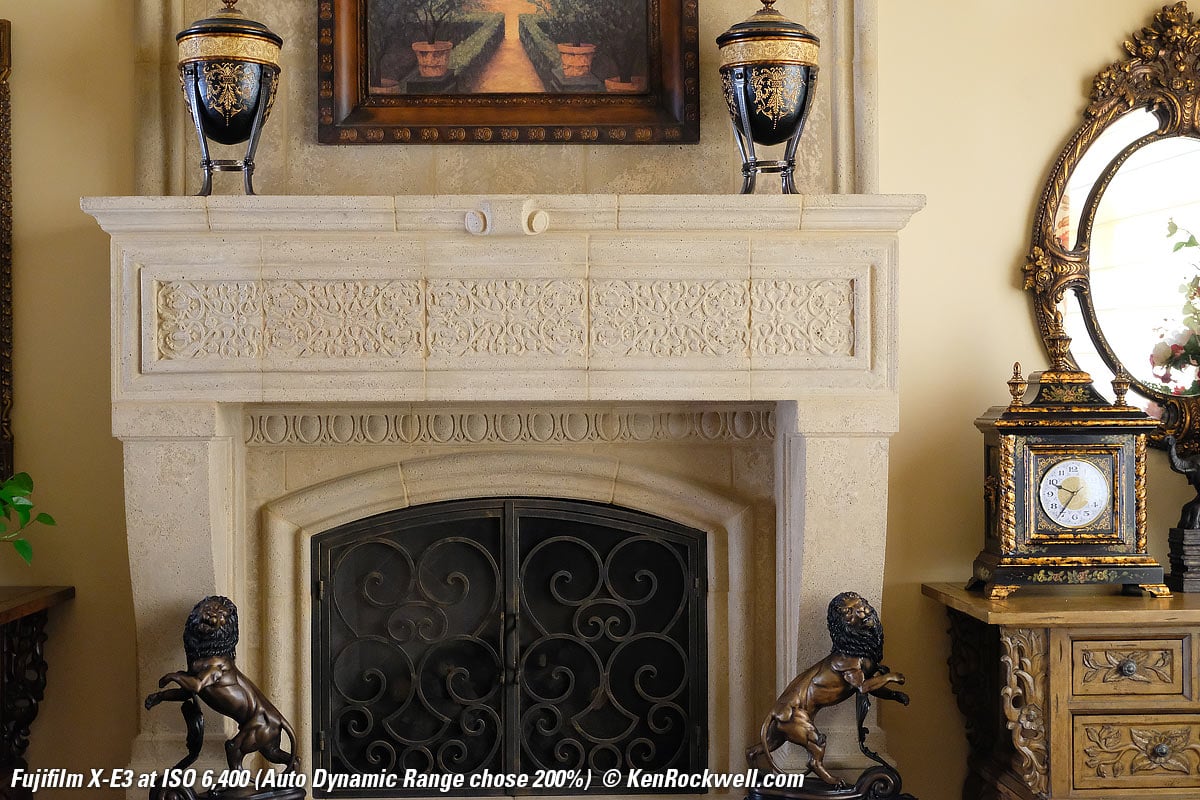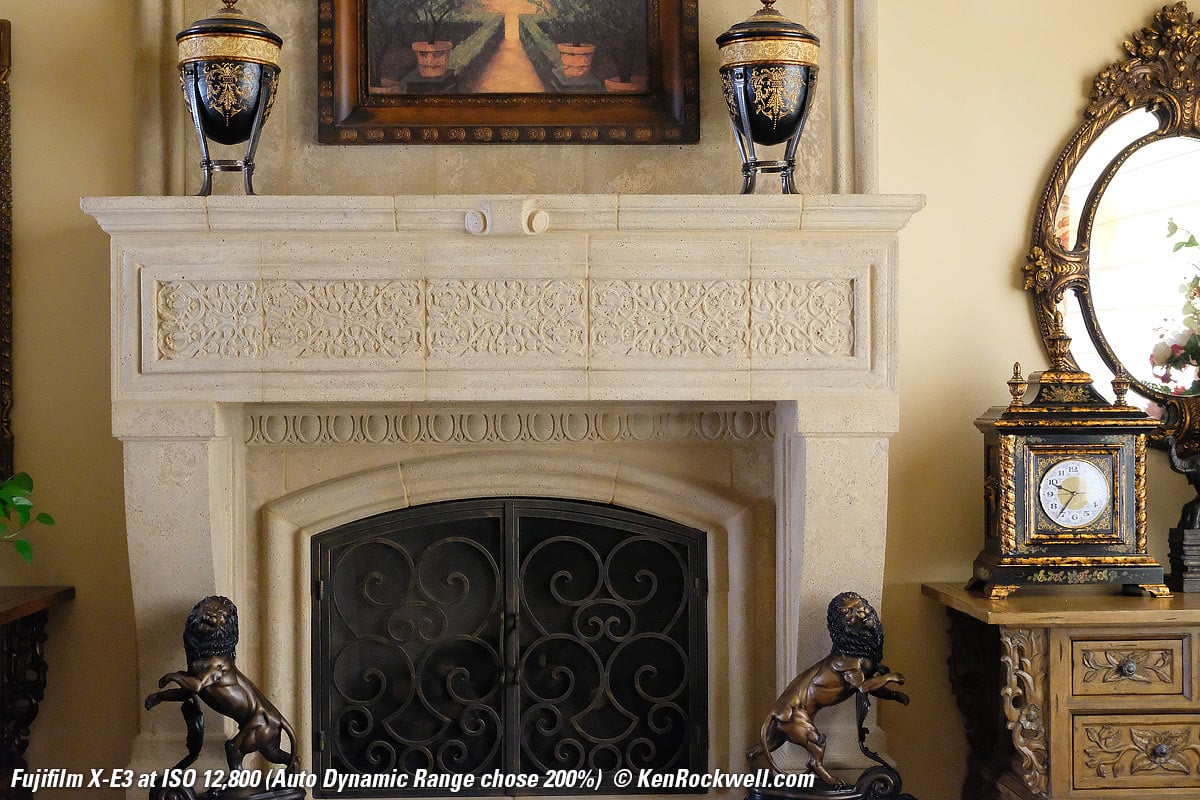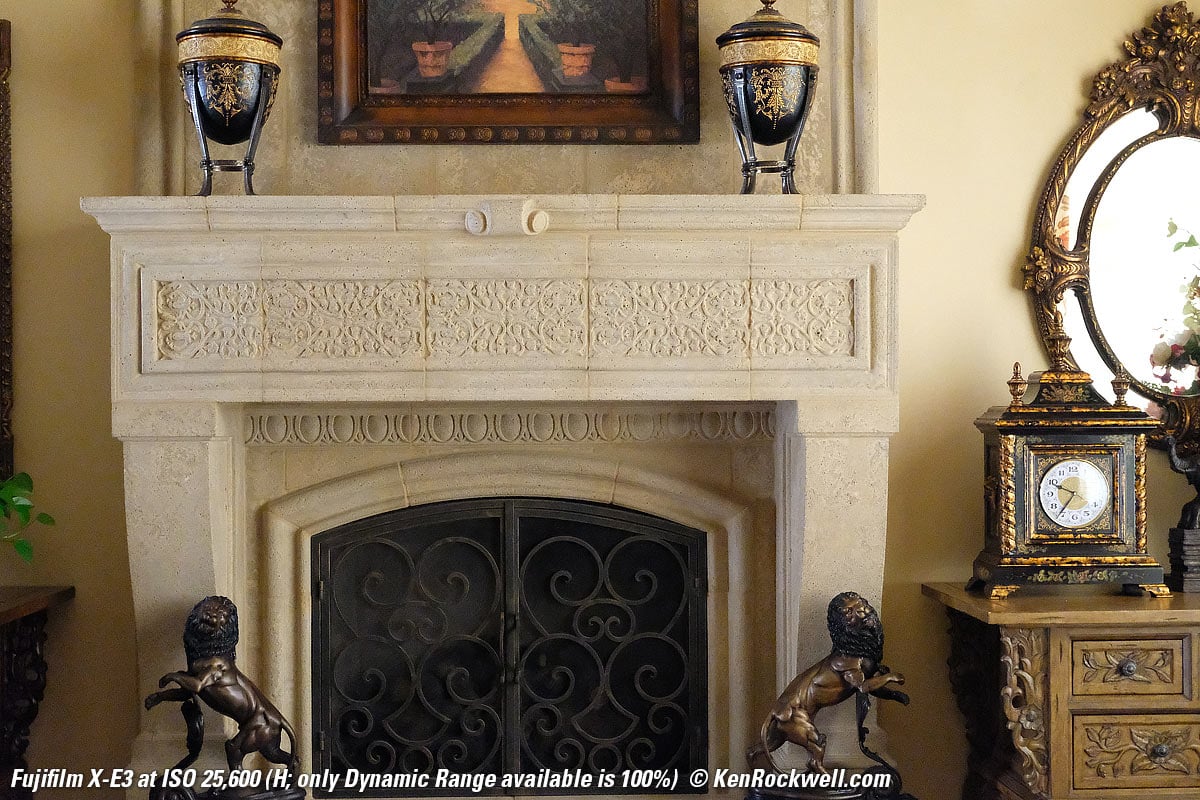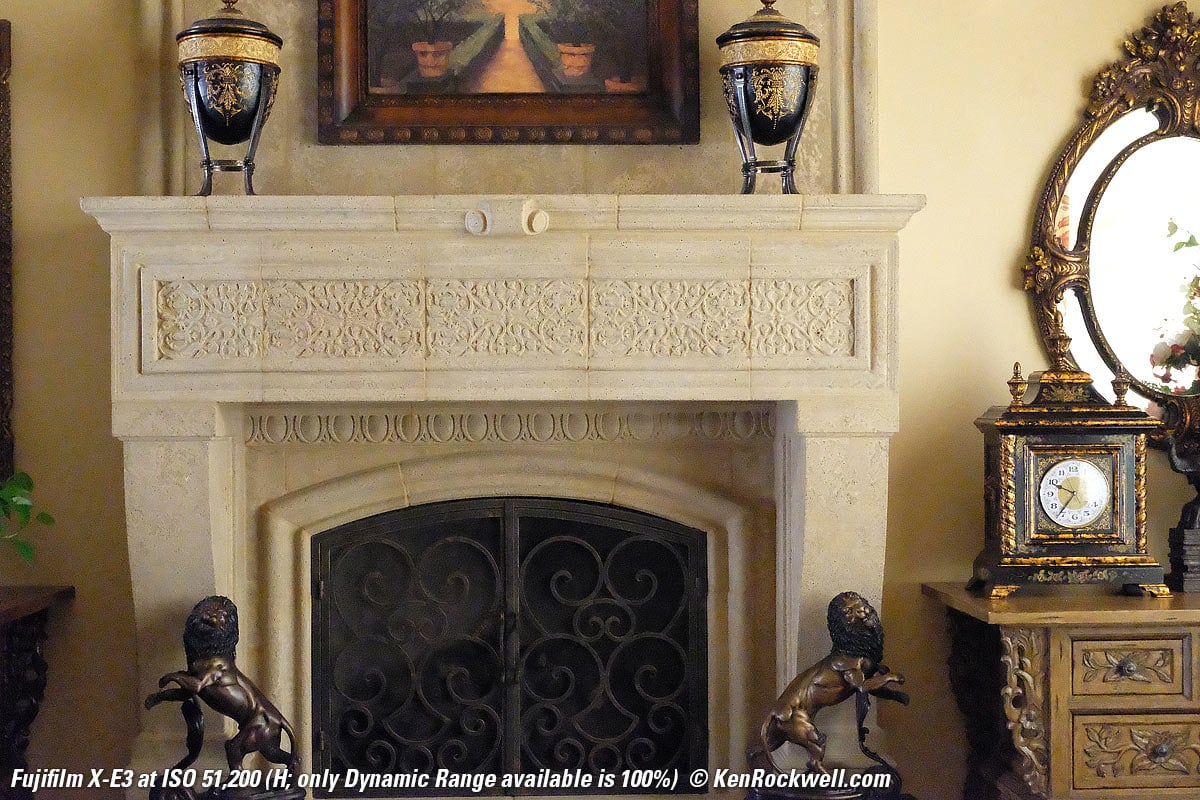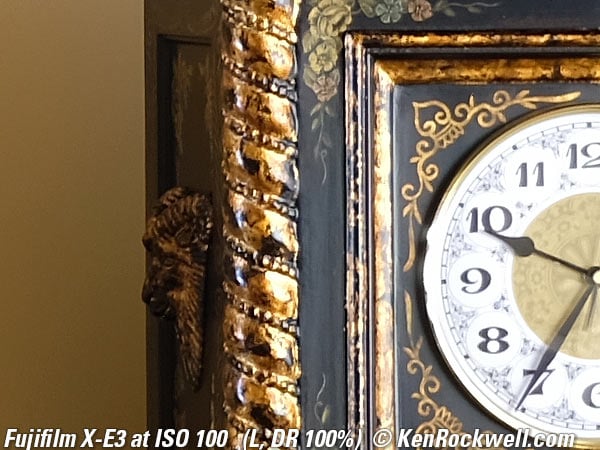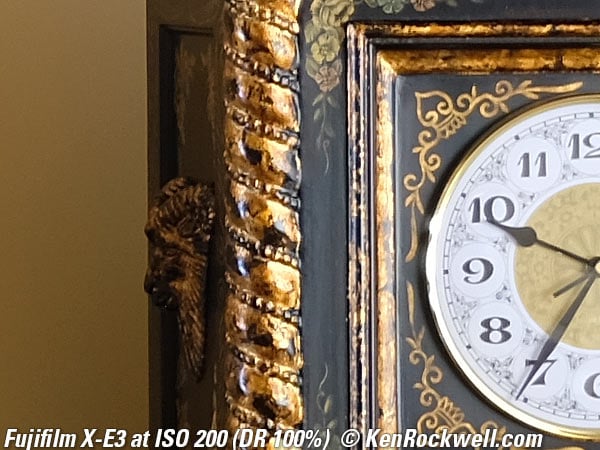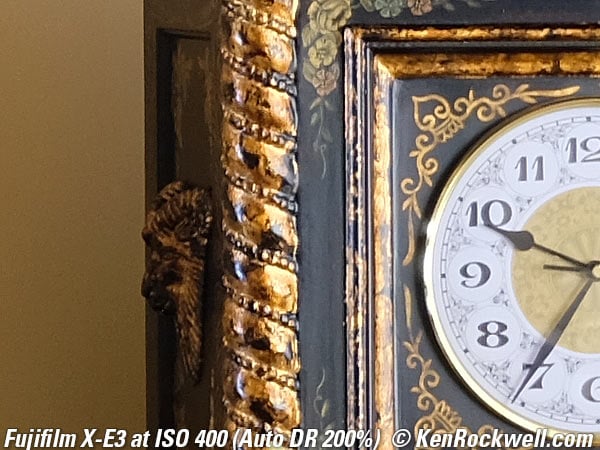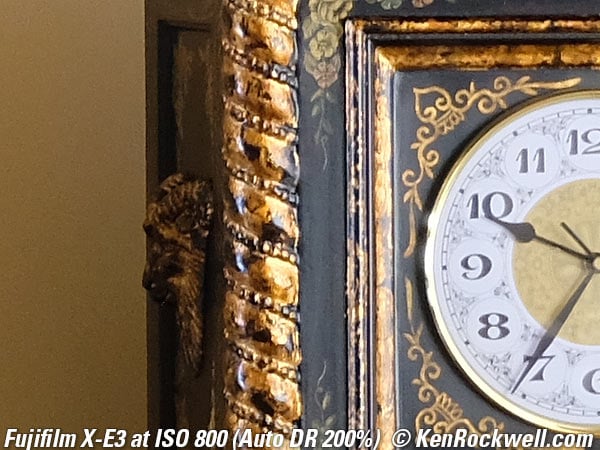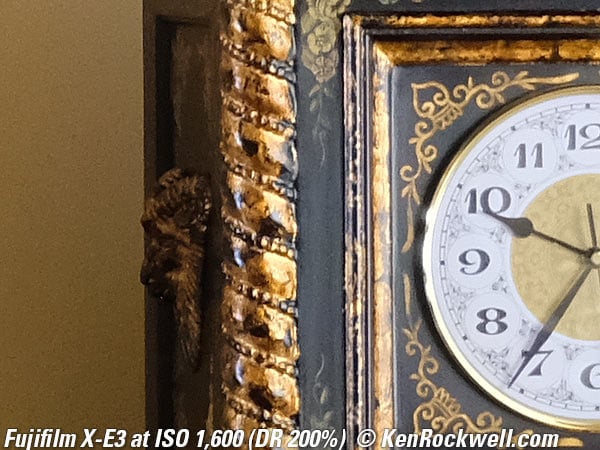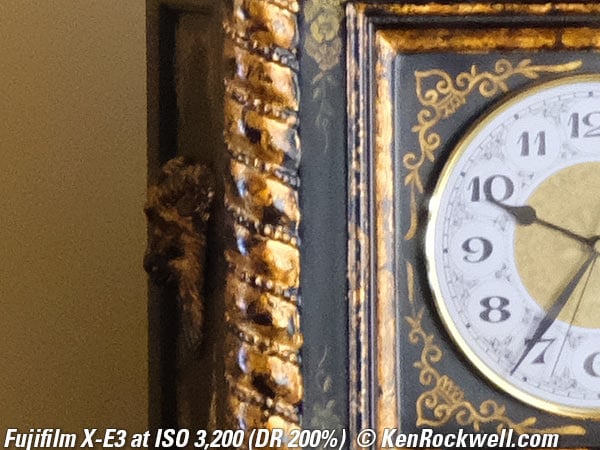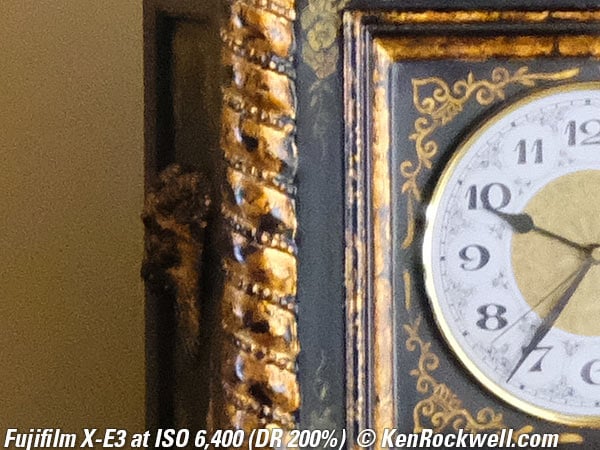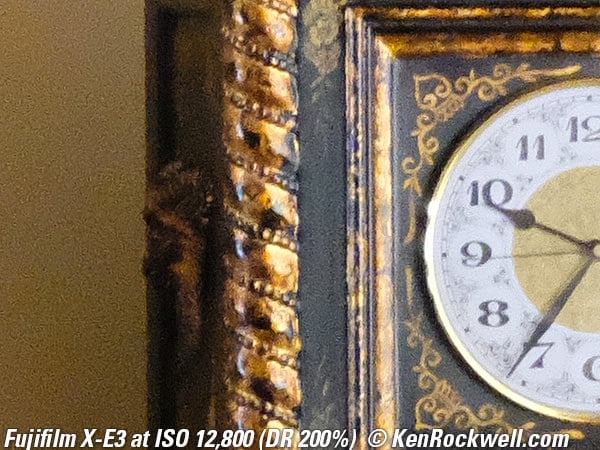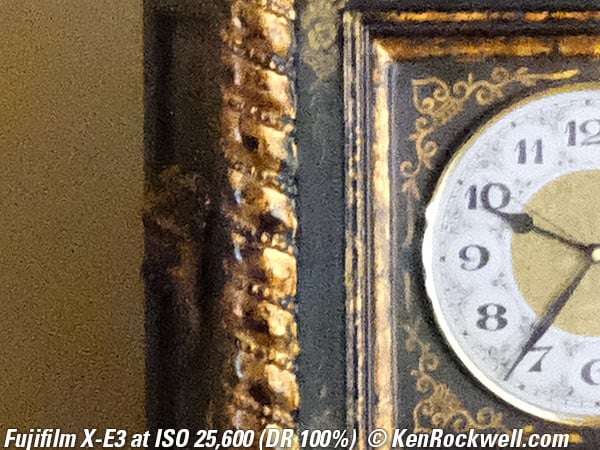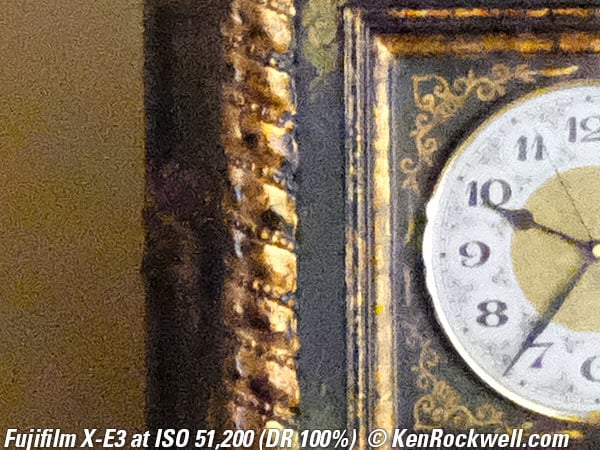Fujifilm X-E3
24 MP APS-C, Silent 14 FPS, ISO 51,200, 4K Stereo
Sample Images Intro Specifications
Performance Compared User's Guide
Fujifilm X-E3 (11.8 oz./334g with battery and card, about $799 new at Amazon or about $500 used if you know How to Win at eBay) and 15-45mm PZ. bigger. It comes in silver and in black.
This all-content, junk-free website's biggest source of support is when you use those or any of these links to approved sources when you get anything, regardless of the country in which you live. Thanks for helping me help you! Ken.
June 2021 Better Pictures Fuji Fuji Lenses Sony LEICA Zeiss Nikon Canon All Reviews
Fujifilm X-E3. bigger or fill-screen.
Fujifilm X-E3. bigger or fill-screen.
Sample Images
Performance Compared User's Guide
(More at High ISOs. These are just snapshots and there are many more throughout the review; my real work is in my Gallery.)
These are all shot as NORMAL JPGs; no FINE JPGs or raw files were used or needed. I don't need raw files, but suit yourself, and the X-E3 can shoot raw files if you prefer.
Friday Night Concert at the Park, 09 August 2019, 7:32 PM. Fujifilm X-E3, Fujifilm XC 50-230mm at 135mm at f/6 at 1/640 at Auto ISO 400 (LV 12.5), as shot. bigger or camera-original © file.
Kona Ice Truck at the Park at Night, 09 August 2019, 8:45 PM. Fujifilm X-E3, Fujifilm XC 15-45mm at 15mm at f/3.4 at 1/45 at Auto ISO 5,000 (LV 3.5), Perfectly Clear. bigger or camera-original © file.
Mark Wood and the Mark Wood Band at the Friday Night Concert at the Park, 09 August 2019, 8:35 PM. Fujifilm X-E3, Fujifilm XC 50-230mm at 107mm at f/5.6 at 1/240 at ISO 51,200 (LV 4), as shot. bigger or camera-original © file.
Trumpeter, Mark Wood Band at the Friday Night Concert at the Park, 09 August 2019, 8:55 PM. Fujifilm X-E3, Fujifilm XC 50-230mm at 153mm at f/6.2 at 1/280 at ISO 51,200 (LV 4.4), as shot. bigger or camera-original © file.
2008 Ford Mustang Shelby GT-C, 11 August 2019, 10:42 AM. Fujifilm X-E3, Fujifilm XC 15-45mm at 45mm at f/8 at 1/1,700 at Auto ISO 400 (LV 14¾), as shot. bigger or camera-original © file.
Provencal tablecloth, 11 August 2019,11:23 AM. Fujifilm X-E3, Fujifilm XC 15-45mm at 45mm at f/5.6 at 1/600 at ISO 200 (LV 13⅓), 100% dynamic range, as shot. bigger or camera-original © file.
Orange Path, 11 August 2019, 6:51 PM. Fujifilm X-E3, Fujifilm XC 15-45mm at 15mm at f/3.5 at 1/20 at Auto ISO 320 (LV 6.4), as shot. bigger, or camera-original © file.
La Virgen de Guadalupe, 11 August 2019, 7:07 PM. Fujifilm X-E3, Fujifilm XC 15-45mm at 19mm at f/5.6 at 1/40 at Auto ISO 200 (LV 8⅓), 100% dynamic range, Perfectly Clear. bigger or camera-original © file.
Méxican Lights, Solana Beach, 11 August 2019, 7:18 PM. Fujifilm X-E3, Fujifilm XC 15-45mm at 45mm at f/5.6 hand-held at 1/8 of a seconds at Auto ISO 2,000 (LV 3⅔), Perfectly Clear. bigger, full-resolution or camera-original © file.
The ectoplasm along the top is a spinning fan blade.
White Flight, 12 August 2019, 11:14 AM. Fujifilm X-E3, Fujifilm XC 15-45mm at 45mm at f/5.6 hand-held at 1/30 at Auto ISO 800 (LV 7), Perfectly Clear. bigger or camera-original © file.
Seven Palms, California Desert, 17 August 2019, 6:54 PM. Fujifilm X-E3, Fujifilm XC 15-45mm at 29mm at f/5.6 at 1/400 at Auto ISO 200 (LV 12⅔), 100% dynamic range, as shot. bigger or camera-original © file.
Tampico Market, California Desert, 18 August 2019, 2:23 PM. Fujifilm X-E3, Fujifilm XC 15-45mm at 15mm, -⅔ stop exposure compensation, f/3.5 at 1/90 at Auto ISO 400 (LV 8⅙), Perfectly Clear. bigger, full-resolution or camera-original © file.
To control the dynamic range between the neon signs and the dark shadows I shot with -⅔ stop exposure compensation to make it a bit darker to hold the highlights (as you can see in the camera-original © file), and then I used Perfectly Clear which I knew would bring up just the dark shadows and midtones without blowing-out the highlights. This is much better than lowering the overall contrast; this preserves full contrast everywhere while taming the lighting range. I saw all this in my head before I shot, and of course I shot this as a NORMAL JPG; amateurs tend not to realize that you can do all the same dynamic, exposure and white balance processing on JPGs exactly the same way you can with clumsy raw files.
Andalusian Palm and Tile Mansion, España, 20 August 2019, 8:04 AM. Fujifilm X-E3, Fujifilm XC 15-45mm at 15mm, -⅔ stop exposure compensation, f/5.6 at 1/1,700 at Auto ISO 400 (LV 13¾), Perfectly Clear. bigger, full-resolution or camera-original © file.
I realized that so long as I held the highlights in my camera-original © JPG file that Perfectly Clear would let me see all the way into the deepest shadows, with no need for old-fashioned multi-shot tripod-mounted HDR. I added some color to the Fuji's typically drab colors (even though I always shoot my Fuji cameras at +4 color saturation) in Photoshop CS6. The rest of these shots are as the colors came from the X-E3; in this shot of the Palm Mansion I wanted to let you all see the warm morning sunlight draping across this fine Spanish home.
Andalusian Fountain at Dusk, 20 August 2019, 8:12 PM. Fujifilm X-E3, Fujifilm XC 50-230mm at 101mm at f/11 for 10 seconds at ISO 200 (LV 2½), 100% dynamic range, as shot except that I burnt-in (darkened) the fluff on the top left. bigger or camera-original © file.
Andalusian Palm Mansion at Dusk, 20 August 2019, 8:06 PM. Fujifilm X-E3, Fujifilm XC 15-45mm at 15mm at f/8 for 30 seconds at ISO 200 (LV 0), 100% dynamic range, Perfectly Clear. bigger, full-resolution or camera-original © file.
The tops of the trees were blowing around in this time exposure and are supposed to be blurry.
Introduction
Performance Compared User's Guide
|
I buy only from these approved sources. I can't vouch for ads below. |
As you've seen in the Sample Images that I shot in less than a week-and-a-half of fooling around, the X-E3 easily takes great pictures of just about anything under any conditions, even with Fujifilm's very cheapest all-plastic XC 15-45mm and XC 50-230mm lenses as I used here.
The X-E3 looks, feels and handles like the premium camera it is. When I first saw one I had no idea how inexpensive it was until I checked. It's built as well as Fujifilm's top cameras, and even uses exactly the same battery.
The X-E3 is Fujifilm's lightest interchangeable-lens camera, it's expertly made out of mostly metal and it takes exactly the same pictures as any of Fujifilm's more expensive cameras. Isn't small size, weight, great construction and great pictures why you wanted a mirrorless camera in the first place? You can pay more, but you can't get any better pictures with a more expensive camera or lens.
All you lose compared to more expensive cameras are extra buttons and dials; picture quality is the same, and the Live View through the X-E3's finder is even sharper than that of some more expensive cameras like my X-T30. I also love how my X-E3 has its play button on the correct (right) side where I can hit it with my thumb while holding the X-E3 in one hand; I have to use a second hand to hit the left-side play button on my X-T30. The X-T30 costs 50% more, and I prefer this X-E3 for its superior handling.
This little jewel is perfect for photos of travel, people, family and low-light.
The X-E3 has no built-in flash, and includes a brilliant little EF-X8 flip-up flash instead:
Fujifilm X-E3, included EF-X8 flash and optional 15-45mm PZ. bigger or fill-screen.
This is a great little self-powered flash (no batteries needed because it's powered from the camera) and it's easy to flip it up or down for ON or OFF while shooting — faster than reaching for menus on other Fuji cameras.
I'd get my X-E3 new at Amazon or used at eBay (How to Win at eBay).
New
 First Fujifilm APS-C camera with Bluetooth Low Energy.
First Fujifilm APS-C camera with Bluetooth Low Energy.
 Swipe functions on the rear LCD replace the rear 4-way controller.
Swipe functions on the rear LCD replace the rear 4-way controller.
 No more four-way rear controller; replaced by screen swipes.
No more four-way rear controller; replaced by screen swipes.
 No more built-in flash like the earlier X-E1, X-E2 and X-E2s, includes a tiny external EF-X8 flash instead.
No more built-in flash like the earlier X-E1, X-E2 and X-E2s, includes a tiny external EF-X8 flash instead.
Good
 Tiny rear thumb nubbin joystick.
Tiny rear thumb nubbin joystick.
 Shutter button threaded for a standard cable release.
Shutter button threaded for a standard cable release.
 Very well made, with metal top & bottom plates and dials.
Very well made, with metal top & bottom plates and dials.
 Real spring-loaded connector door; not just a crummy rubber flap like Nikon.
Real spring-loaded connector door; not just a crummy rubber flap like Nikon.
 EF-X8 flash included.
EF-X8 flash included.
 1/32,000 silent electronic shutter and/or regular focal plane shutter.
1/32,000 silent electronic shutter and/or regular focal plane shutter.
 Shutter speeds as long as 15 minutes settable directly with no need for an external cable release or timer. (use the T setting on the shutter dial then set the time with the rear dial.)
Shutter speeds as long as 15 minutes settable directly with no need for an external cable release or timer. (use the T setting on the shutter dial then set the time with the rear dial.)
 Face- and eye-recognition autofocus — but eye-recognition doesn't work in AF-C mode where you'd need it.
Face- and eye-recognition autofocus — but eye-recognition doesn't work in AF-C mode where you'd need it.
 Two control dials (front and rear).
Two control dials (front and rear).
 Both straight and pulled-down video rates (24 and 23.976 FPS, for instance)
Both straight and pulled-down video rates (24 and 23.976 FPS, for instance)
 Battery charges through Micro USB, as well as the included charger.
Battery charges through Micro USB, as well as the included charger.
 Programmable file name prefixes.
Programmable file name prefixes.
Bad
 Offshored to China; not made domestically in Japan.
Offshored to China; not made domestically in Japan.
 Longest video take length 10 minutes at 4K and 15 minutes at 1,080. Only runs 30 minutes at 720.
Longest video take length 10 minutes at 4K and 15 minutes at 1,080. Only runs 30 minutes at 720.
Missing
 No automatic brightness control for rear LCD (finder has automatic brightness control).
No automatic brightness control for rear LCD (finder has automatic brightness control).
 Flexible Auto ISO system, except that you can't offset the automatically-selected slowest shutter speeds if you select AUTO for Minimum Shutter Speed in Auto ISO. (Hint: just turn the shutter speed dial in most cases and Bingo!, you just set that as the shutter speed around which Auto ISO will work.)
Flexible Auto ISO system, except that you can't offset the automatically-selected slowest shutter speeds if you select AUTO for Minimum Shutter Speed in Auto ISO. (Hint: just turn the shutter speed dial in most cases and Bingo!, you just set that as the shutter speed around which Auto ISO will work.)
 No 4:3 "Ideal Format" crop.
No 4:3 "Ideal Format" crop.
 No 4-way rear controller and touch-screen swipes don't work as well as real buttons.
No 4-way rear controller and touch-screen swipes don't work as well as real buttons.
 Screen doesn't swivel. So?
Screen doesn't swivel. So?
 Eye recognition autofocus doesn't work in continuous autofocus (AF-C); only works in autofocus and lock mode (AF-S).
Eye recognition autofocus doesn't work in continuous autofocus (AF-C); only works in autofocus and lock mode (AF-S).
 Electronic level only works in one axis (Dutch or roll or left/right tilt), but not for pitch (up/down tilt).
Electronic level only works in one axis (Dutch or roll or left/right tilt), but not for pitch (up/down tilt).
 Lots of autofocus sensors, but they don't reach all the way to the top or bottom. They do cover almost all the way to the left and right edges.
Lots of autofocus sensors, but they don't reach all the way to the top or bottom. They do cover almost all the way to the left and right edges.
 It's great that the shutter is settable all the way out to 15 minutes, but strange is that it only sets in full stops from one minute to 15 minutes.
It's great that the shutter is settable all the way out to 15 minutes, but strange is that it only sets in full stops from one minute to 15 minutes.
 Mic/remote in jack, but no headphone jack.
Mic/remote in jack, but no headphone jack.
Specifications
Performance Compared User's Guide
I'd get my X-E3 new at Amazon or used at eBay (How to Win at eBay).
Lens Compatibility
Works only with Fuji's X-mount APS-C Lenses, and anything else you can adapt to it.
Fujifilm X-E3. bigger or fill-screen.
Image Sensor
24 MP.
15.6 × 23.5 mm CMOS.
3:2 aspect ratio.
1.5× crop factor.
Ultrasonic cleaner.
ISO
ISO 200 ~ 12,800 optimum, also runs at ISO 100, 125 and 160 (L) and 25,600 and 51,200 (H).
Auto ISO
Three Auto ISO presets.
Low limit adjustable from ISO 200 to ISO 12,800 in third stops.
High limit adjustable from ISO 400 to ISO 12,800 in full stops.
Auto ISO minimum shutter speeds adjustable from 1/4 to 1/30 in full stops, from 1/30 to 1/500 in third stops, or one unadjustable AUTO setting.
Image Sizes
6,000 × 4,000 pixels native (L, 24.00 MP).
4,240 × 2,832 (M, 12.0 MP).
3,008 × 2,000 (S, 6.0 MP).
Square Crops
L: 4,000 × 4,000.
M: 2,832 × 2,832.
S: 2,000 × 2,000.
16:9 Crops
L: 6,000 × 3,376.
M: 4,240 × 2,384.
S: 3,008 × 1,688.
Swept Panoramas
2,160 × 9,600 (L; Horizontal: 9,600 × 1,440).
2,160 × 6,400 (M; Horizontal 6,400 × 1,440).
Still Formats
JPG and/or raw.
sRGB and Adobe RGB.
Still-Photo Frame Rates & Buffer (Burst) Sizes
Mechanical Shutter
8 FPS: JPG: 62 frames, Lossless compression RAW: 25 frames, Uncompressed RAW: 23 frames.
5 FPS: JPG: 68 frames, Lossless compression RAW: 28 frames Uncompressed RAW: 25 frames.
4 FPS: JPG: 73 frames, Lossless compression RAW: 29 frames Uncompressed RAW: 25 frames.
3 FPS: JPG: 81 frames, Lossless compression RAW: 32 frames Uncompressed RAW: 27 frames.
Electronic Shutter
14 FPS: JPG: 35 frames, Lossless compression RAW: 22 frames, Uncompressed RAW: 21 frames.
11 FPS: JPG: 53 frames, Lossless compression RAW: 23 frames, Uncompressed RAW: 21 frames.
Video
File Format
.MOV file holding MPEG-4 AVC / H.264 video and Stereo Linear Pulse-Code Modulation 48 ksps audio.
4K
29.97, 25, 24 or 23.976p.
Maximum take length: 10 minutes.
1,080
59.94, 50, 29.97, 25, 24 or 23.976p.
Maximum take length: 15 minutes.
720
59.94, 50, 29.97, 25, 24 or 23.976p.
Maximum take length: 30 minutes.
Audio
Recorded only along with video.
S - t - e - r - e - O microphone built in.
Mic-in jack with plug-in power overrides built-in mic.
No headphone jack.
Autofocus
TTL Phase and / or contrast detection.
13 × 7 or 25 × 13 matrix (selectable).
Light Meter
256-zone through-the-lens metering.
Multizone, Spot, Average and Center Weighted patterns.
Electronic Finder
0.39" OLED.
4:3 aspect ratio.
2,360,000 dots.
0.62× magnification with 35mm (actual) lens.
0.93× magnification with 50mm (actual) lens.
30º diagonal (25º horizontal) apparent angle.
Auto brightness control.
+2 ~ -4 diopters.
17.5 mm eyepoint.
Shutters
Mechanical Shutter
1/4,000 to 4 seconds (P mode), to 30 seconds (A mode), to 15 minutes (S or M modes) or to one hour in Bulb mode.
Flash sync speed: 1/180.
Silent Electronic Shutter
1/32,768 to 4 seconds (P mode), to 30 seconds (A mode), to 15 minutes (S or M modes) or only 1 second in Bulb mode.
Remote Releases
Standard threaded cable release.
Flash
1/180 sync speed.
Included EF-X8 flash
GN 26'/8m at ISO 100.
External Flash
Dedicated hot shoe.
No Prontor-Compur (PC) terminal; use the included flash to trigger your slaves or just use a hot-shoe adapter for corded sync.
LCD Monitor
3" (76 mm) diagonal.
1,040,000 dots.
3:2 aspect ratio.
Does not swivel.
No anti-smudge coating.
No anti-reflection coating.
Connectors
Fujifilm X-E3. bigger or fill-screen.
From the top:
2.5mm stereo mic or remote connector.
HDMI micro-D.
Micro USB 2.0.
WiFi
802.11 / b / g / n.
Infrastructure.
NFC
None.
Bluetooth
v4.0 LE.
2.402 ~ 2.480 GHz.
GPS
None.
Storage
SD (up to 2GB), SDHC (up to 32GB) and SDXC (up to 256GB) cards.
Quality
Fujifilm X-E3. bigger or fill-screen.
Made in China.
Power & Battery
Rated 350 shots (or about 50 minutes of video) per charge without flash using the LCD.
New NP-W126S Li-Ion battery. Same as used in theX-T30, X-T3, X-100F and X-T2; it's a newer version of the NP-W126 used in the X-Pro1 and X-E1.
7.2V, 1,260 mAh.
1.4 × 1.9 × 0.6 inches.
36.4 × 47.1 × 15.7 millimeters.
Rated 1.7 oz. (47g).
Charging
It charges via USB using any random cable and regular 5V USB source, or with the included external charger:
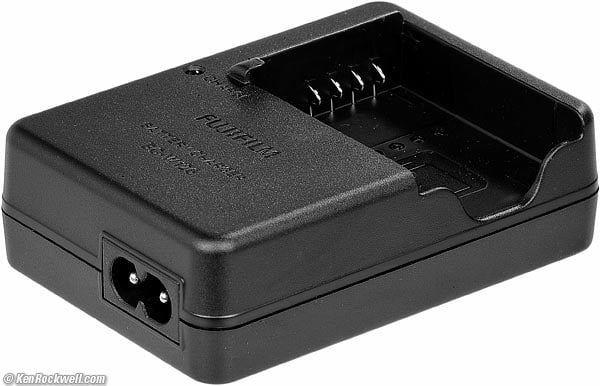
Fuji BC-W126 Charger.
BC-W126 (same as X-E1, X-Pro1 and X-T1).
Corded, uses common "∞" shaped plug end.
100~240V, 50-60 Hz.
Made in China by JET.
Rated 13~21 VA input, 8.4VDC 0.6A output.
Size
2.91× 4.78 × 1.68 inches HWD.
73.9 × 121.3 × 42.7 millimeters HWD.
Minimum Depth: 1.28"/32.4mm.
Weight
X-E3 body
11.780 oz. (334.0g) with battery and card, actual measured weight.
Rated 11.9 oz. (337g) with battery and card, 10.1 oz. (287g) stripped.
EF-X8 flash
1.415 oz. (40.0g), actual measured weight.
Operating Environment
0 ~ 40º C (32-104º F).
10 ~ 80% RH, non-condensing
Included
Camera.
Body cap.
Li-ion battery NP-W126S.
Battery charger BC-W126.
Shoulder strap.
Metal strap clip.
Protective cover.
Clip attaching tool.
Owner's manual.
Announced
07 September 2017.
Promised for
28 September 2017.
Price, USA
June 2021
About $500 used at eBay (How to Win at eBay).
August-September 2019
$599 new at Adorama, at Amazon, at B&H or at Crutchfield. Comes in silver as seen here or in black and as many kit options as you'll see at those links.
About $500 used if you know How to Win at eBay.
Unboxing
Top Sample Images Intro Format Compatibility Specifications Accessories
Unboxing USA Version Performance Compared User's Guide Recommendations More
I'd get my X-E3 new at Amazon or used at eBay (How to Win at eBay).
Performance
Top Sample Images Intro Specs Unboxing
Performance Compared User's Guide
Overall Autofocus Color & Tone Rendition
Ergonomics Exposure Finder Flash
High ISOs Lens Corrections Long Exposures
Mechanics Playback Data Power & Battery
I'd get my X-E3 new at Amazon or used at eBay (How to Win at eBay).
Overall
The Fuji XE3 is inexpensive, built as well and works possibly better than Fuji's more expensive cameras. It may not have quite as many features, but all the basic and moderately advanced ones are here and the pictures look the same, so if you think you might like the X-E3, you'll LOVE it.
Autofocus
Autofocus is as good as the other Fujifilm cameras.
It's fast and super accurate for still images, but its AF areas don't quite make it all the way to the top and bottom of the frame, and autofocus isn't as fast and as smart as I'd want it for shooting action. If sports and action are your thing, go for a DSLR or a Sony mirrorless camera.
While the X-E3 has face recognition and eye recognition, it cannot recognize eyes in AF-C. It only does eye recognition in AF-S, which seems a bit silly, but is limited by the processing power inside the X-E3.
Color & Tone Rendition
Color rendition has nothing to do with color reproduction or color accuracy. Rendition is simply how colors look; do they match the artist's vision, or not? Every artist sees differently, thus every artist chooses the brand of camera which gets him closest to his vision. Ditto for tone (brightness) rendition; there is no "correct;" only what looks best to an individual artist.
Color rendition of the X-E3 is the same as other Fujifilm cameras. This means that in-camera JPGs tend towards muted colors and low contrasts ideal for people pictures. Even set to COLOR +4 as I've shot everything here the colors are more subdued than the maximum saturation settings I get from other brands — but I'm an insane artist whose taste in saturation goes way beyond what's accepted in polite company.
Contrast is also generally lower than in other brands of cameras. The Fujifilm cameras are fantastic for people pictures and portraits under any kind of mixed light, but for photos of places and things I prefer the wilder colors I can get from other brands of camera, straight out of the camera as JPGs.
I'm not a fan of the film emulation and special picture modes; use these as you see fit.
If you shoot raw then color rendition depends on your choice of software. I don't bother with raw.
Ergonomics
The self timer always cancels when you turn off the camera and there is no way to program it to stay ON or OFF. This is good for most people, but drives me nuts when I'm shooting on a tripod and using it to eliminate shake shooting without a cable release.
Good
This jewel of a little camera is loaded with clearly engraved dials for shutter speed and exposure compensation and a switch on the front for AF mode making these items much easier to set than on other brands of camera which more often force these settings into unnamed dials and function buttons.
The PLAY and TRASH buttons are on the correct (right) side so we can hit them while shooting with one hand.
There are two control dials, one front and one rear.
The X-E3 has a nice little spring-loaded connector door that flips open or closes easily that's a huge advantage over the crappy plastic flaps that fall off of Nikon, Sony and Canon's mirrorless cameras.
It's easier to use the X-E3's ISO controls in menus than it is to use the defective ISO dials on other Fujifilm cameras. Sadly Fujifilm's ISO dials skip a couple of values, and demand you go back into much more complex menus to program which values you want to assign to the H and L settings of those dials — while it's easy to set any ISO value with any of the X-E3's buttons or screen swipes programmed to ISO (MENU > WRENCH > BUTTON/DIAL SETTING > Fn SETTING > (your choice of Fn button) > ISO. An even easier way to set these is just to hold the DISP BACK button for a few seconds and the same menu pops up!)
Long exposures up to 15 minutes are counted-down on the screen (LCD or finder) that was active when the shutter was pressed. This way you know how much time is remaining.
Bad
This is a frustrating camera to set up unless you're both patient and talented. Most users will never figure out how to use most of the fancier features, and Heaven help you if you only use it once a month. See my Fuji X-E3 User's Guide, especially about how to figure out the touch screen.
The menu system is the worst in the industry, maybe even worse than Sony's awful menu system which hides settings under unclear labels in multiple random locations. All Fuji cameras take longer than they should to find and set menu items, and even if you find the right item, you might not recognize it.
Once you get your menus and camera set as you want it, it shoots fast due to all the dials, but unless you use your camera often you'll forget where to find things.
Almost every time you press MENU it wakes up back at the top, not where you just were, so you almost always have to drill down through the whole system to get back where you what you were setting.
There's no 4-way rear controller, and the touch screen and thumb nubbin are much harder to use to make basic settings (see my Fuji X-E3 User's Guide).
It ignores the front dial when making settings from the Q screen.
The rear dial turns backwards when setting items at the Q screen (ISO or color saturation increase when moving left, for instance), and there is no option to reverse the dial directions.
The small, slippery front and rear metal control dials aren't that comfy.
The shutter dial is too small; it doesn't hang over the back so you have to reach forward with your thumb to get to it.
The shutter dial doesn't rotate between the B and A positions. You have to rotate it the long way around in the other direction to get between them.
The tripod socket isn't directly under lens, making it harder to find in the dark.
The card and battery door lacks a spring catch, so you have to remember to slide catch manually to lock it.
The card is right by the door hinge so it's difficult to grab. It's often easier to push it in and release to let it shoot it across room than try to pull it out.
Oddly while Long Exposure NR is running after a long time exposure that is counted down, there is no count-down of the dark-frame exposure which is usually as long as the original time exposure. Make a 30 second exposure and after the first 30 seconds get counted down, it shows PROCESSING 00:00 for another 30 seconds.
Exposure
Like most mirrorless cameras, exposure is almost always perfect.
Finder
The finder is very good, sharp and bright, with pretty good automatic brightness control. While Sony does automatic brightness control better, this Fuji is way ahead of Nikon's or Canon's full-frame mirrorless which usually require manual brightness adjustment as conditions change.
The finder has an even sharper screen while shooting than my X-T30, which costs 50% more. Forget the OLED finder specifications; the X-E3 uses better processing to deliver more pixels to the OLED during live view than my X-T30 does.
The X-E3' eyepiece optics aren't as good as more expensive cameras like the X-T30 or amazing X-H1, so while the OLED is sharper, you won't always see all of that OLED as sharply as you move your eye around. Some parts may be blurrier than other parts of the screen as you move your eye or change the eyepiece focus adjustment.
The biggest gotcha with the X-E3's finder is that the brightness is set depending on what light is coming through the front of the lens, not light coming into the finder from behind. If you point the camera down at a shadow while you're playing back outside, the finder gets too dark. You have to be conscious of where you're pointing it to get the finder brightness right, especially for playback.
The X-E3's sharp and bright finder is more than good enough to let me see what I'm shooting and what I've shot. The X-H1's finder is amazing and a joy to behold, but it doesn't beget any better pictures because of it.
Flash
Fujifilm X-E3, included EF-X8 flash and optional 15-45mm PZ. bigger or fill-screen.
The tiny little included EF-X8 flash works great, and of course any other Fujifilm EF flash works well.
The beauty of this tiny EF-X8 flash is that it's powered directly from the camera's battery, so there's no separate battery to change or charge.
Also great is that the EF-X8 flash need no power switch: It pivots at its base, so flip it up and it's on or down and it's off.
It has a great lock so, better than any of my Sony, Nikon or Canon flashes, it always stays put.
The only downsides are that the X-E3's relatively slow 1/180 sync speed limits the flash range for daylight fill, and it can take a long time (several seconds) to recycle.
High ISO Performance
High ISO performance is wonderful, as we expect with modern cameras. Any setting up to 51,200 looks great if you actually need it:
ISO 5,000
Kona Ice Truck at the Park at Night, 09 August 2019, 8:45 PM. Fujifilm X-E3, Fujifilm XC 15-45mm at 15mm at f/3.4 at 1/45 at Auto ISO 5,000 (LV 3.5), Perfectly Clear. bigger or camera-original © file.
ISO 51,200
Mark Wood and the Mark Wood Band at the Friday Night Concert at the Park, 09 August 2019, 8:35 PM. Fujifilm X-E3, Fujifilm XC 50-230mm at 107mm at f/5.6 at 1/240 at ISO 51,200 (LV 4), as shot. bigger or camera-original © file.
Trumpeter, Mark Wood Band at the Friday Night Concert at the Park, 09 August 2019, 8:55 PM. Fujifilm X-E3, Fujifilm XC 50-230mm at 153mm at f/6.2 at 1/280 at ISO 51,200 (LV 4.4), as shot. bigger or camera-original © file.
Of course you lose detail at ISO 51,200 and it's a little noisier, but so what, if you need 51,200 to be able to use a short enough shutter speed to stop action at night as I've done here, go for it.
Complete High ISO Sample Image Files
Click any for the camera-original © files to explore on your computer (mobile devices rarely show the full resolution files properly):
600 × 450 Pixel Crops from above
Click any for the camera-original © files to explore on your computer:
The 600 × 450 pixel crops above vary in size to fit your browser window.
If these are about 3" (7.5cm) wide on your screen, the complete images would print at 20 × 30" (50 × 75 cm) at this same high magnification.
If these are about 6" (15cm) wide on your screen, the complete images would print at 40 × 60" (1 × 1.5 meters) at this same extreme magnification.
If these are about 12" (30cm) wide on your screen, the complete images would print at 80 × 120" (2 × 3 meters) at this same insanely high magnification.
Lens Corrections
There is an option for a Digital Lens Optimizer at MENU > I.Q. > LENS MODULATION OPTIMIZER which is set either ON or OFF, and that's it. All the corrections are done, or not.
Long Exposures
Great is that shutter speeds as long as 15 minutes are settable directly with no need for an external cable release or timer. Use the T setting on the shutter dial then set the time with the rear dial.
Long exposures up to 15 minutes are counted-down on the screen (LCD or finder) that was active when the shutter was pressed. This way you know how much time is remaining.
Oddly while Long Exposure NR is running after a long time exposure there is no count-down of the dark-frame exposure which is usually as long as the original time exposure. Make a 30 second exposure and after the first 30 seconds get counted down for the actual exposure, it shows PROCESSING 00:00 for another 30 seconds as it makes the dark-frame for long-exposure noise reduction.
Mechanical Quality
The X-E3 is made better than most Canon, Sony and Nikon cameras, with loads of metal where many more-expensive cameras settle for crummy plastic:
Metal
Strap lugs
Top cover
Hot shoe
Shutter speed dial
Power switch
Shutter button
Exposure Compensation dial
Front control dial
Rear control dial
Lens Mount
Bottom cover
Tripod socket
Plastic
● - AUTO lever under shutter speed dial
All buttons
Rear thumb nubbin (a.k.a. joystick or "Focus Lever")
Eyepiece frame and its focus wheel
Everything black between top and bottom covers:
Fake leather covering
Grip
M / AF-C / AF-S switch on front
Lens release button
Connector door
Battery & card door
Playback
Playback is the usual from Fuji.
Scrolling around a zoomed image is slow with the rear nubbin, and works great with the touch screen.
The electronic finder uses a 4:3 OLED, and the image never fills it vertically, even when zoomed — except with square images where it does fill the screen vertically both during Live View and as during IMAGE DISPLAY (image review right after shooting), but oddly will never fill the screen as a played-back square image, zoomed or full. Weird.
To swap among different playback display options the X-E3 only responds to up-clicks of the thumb nubbin, but ignores down clicks. Weird. Also to keep you confused you can press the DISP to select more different playback screen options.
Data
Cards are incorrectly formatted as "Untitled," rather correctly as something like FUJI-XE3. When you shoot as much as I do, it's of no help seeing generic "Untitleds" appear in my Mac's finder as I'm trying to identify which card is which.
JPG files are tagged as 72 DPI.
Folders will hold up to 1,000 images, after which the camera makes a new folder on your card.
I download with a card reader. Connected via a USB cord to my Mac in Mojave it shows up only as a device in Image Capture, not in my Finder.
Power & Battery
There's a 5-segment battery icon, and the percentage is hidden. While this icon isn't precise, it's far more precise than other 3-segment icons and gets the job done.
I use a generic 99¢ Micro USB cord and it charges just fine from every USB source I've tried.
It draws 853mA while charging (rear green LED on), and draws 33mA when done.
Video version of this review
Compared
Performance Compared User's Guide
I'd get my X-E3 new at Amazon or used at eBay (How to Win at eBay).
See All Fuji Cameras Compared.
User's Guide
Performance Compared User's Guide
I'd get my X-E3 new at Amazon or used at eBay (How to Win at eBay).
Power & Charging
Use any micro USB cord and USB source and it charges with a green LED on the back. The LED goes out when charged.
I don't bother with the included external charger.
Battery Percentage Indicator
There is a percentage indication, but it is very well hidden.
The only way to see it is only on the rear LCD, only when the camera is ready to shoot (not on playback and not in menus), and only in the one data screen that comes up as you press DISP BACK to change the screen functions.
If you can get the percentage to display, it will be in the top right of that screen.
Strap
I never use Fuji's own straps. They take too long to attach and remove.
I always use LEICA's factory-original straps. It's small, light, strong, comfortable and convenient, and most of all it uses a brilliant design that lets me attach and remove it instantly to the Fuji or LEICA cameras without tools.
AUTO Lever & Unlocking all the Other Advanced Settings
If you want the camera to figure it all out for you, simply pull the tiny "● - AUTO" lever just under the right side of the shutter speed dial to AUTO.
If you want to make your own settings and unlock most of the menu system, be sure to push this towards the power switch to the dot ●. Much of what I'll explain below can't be done with this lever set to AUTO.
Focus Modes
There is an "M / AF-C / AF-S" switch on front of the camera.
S: Single Auto Focus: It autofocuses once and locks until you take the picture. Use this for things that don't move.
C: Continuous Auto Focus: It autofocuses continuously and tries to track motion. Use this for moving things.
M: Manual Focus only.
Exposure Modes
There is no exposure mode switch and no need for one.
Instead, set either or both of the camera's shutter dials or the lens' aperture controls to "A" (AUTO) and that value, or both, will be set automatically while the other value (or values) you set will be used:
Mode |
Aperture Dial* |
Shutter Dial |
Program |
A |
A |
Shutter Priority |
A |
Choose a shutter speed |
Shutter Priority |
Choose an aperture* |
A |
Manual |
Choose an aperture* |
Choose a shutter speed |
* This varies with lens. XF lenses usually have either a dedicated aperture ring with all the f/stops and an A position, while others have a switch marked with an A and a diaphragm icon (manual aperture setting with the camera's front dial), and Fuji's cheapest XC lenses have no aperture controls. With XC lenses you control this with the camera's front control dial.
Shutter Dial & Time Exposures
The shutter dial has a few tricks up its sleeve:
1.) A means AUTO. This gets you Program auto exposure if the aperture is set to A, or gets you shutter-priority if you set an aperture value.
2.) 1 ~ 4000: When you set any marked speed, you can go up or down two thirds of a stop with the rear dial.
3.) 180X is the fastest speed you can use with flash.
4.) T is TIME, but is also the most cleverly designed setting of all because in T you can set any shutter speed with the rear control dial, and you can set it as long as 15 minutes or as fast as 1/32,000 with the electronic shutter.
Long exposures count-down time remaining on the display, but if you have Log Exposure Noise Reduction activated sadly the second dark-frame exposure, which is just as long as the first main exposure, doesn't have any count-down timer and just shows 00:00 the whole time.
Flash Firing
The flash won't work if you're in any of the silent electronic shutter modes, have Anti Flicker turned ON or are in any advance mode other than S (single). If you have any of these set otherwise you simply can't get the flash to work, and the X-E3 will never tell you why; you just have to know to check these.
Images are often warmer with the flash popped up; the auto white balance system is assuming the flash is bluer. This often gives nicer pictures in daylight; try it.
Flash Sync
To select SLOW sync to allow slower shutter speeds to see more ambient light with flash indoors and at night, set MENU > FLASH BOLT (⚡) > FLASH FUNCTION SETTING > and click down to select the small rectangular box on the left marked TTL MODE. Press MENU OK again and you'll see the options for AUTO (flash fires when it thinks it needs to), TTL STANDARD (flash fires) and TTL SLOW SYNC, where the flash fires and the shutter is allowed to go to very slow speeds in low light.
To select front or rear curtain sync, do the same but select these at the small rectangular box marked SYNC. 1st CURTAIN or FRONT is standard (the flash fires as the shutter opens), but at slow speeds where a moving subject is blurred it looks more natural to have the flash fire at the end of the exposure (2nd CURTAIN or REAR), so that the blur appears behind the moving object.
Flash Color
Images are often warmer with the flash popped up; the auto white balance system is assuming the flash is bluer. This often gives nicer pictures in daylight as the ambient light looks warmer than it does without flash; try it and see.
Image Review
To have your just-shot images remain on the screen after you shoot them, set this at MENU > WRENCH > SCREEN SET UP > IMAGE DISP. and choose how long you want each as-shot image to display. "Continuous" means it stays on the screen until you tap the shutter or another button.
Level Display
Enable this at MENU > WRENCH > DISP. CUSTOM SETTING and check the box for ELECTRONIC LEVEL.
Once you've enabled it in the menus, display it (or not) by pressing the rear DISP BACK button.
Program your Buttons and Swipes
To set what the various buttons and LCD swipes do, hold the DISP BACK button for a few seconds and a menu pops up! You can get to this the hard way at MENU > WRENCH > BUTTON/DIAL SETTING > FUNCTION (Fn) SETTING.
Using the Touch Screen and Swipes (Touch Functions/T-Fn)
The touch screen is almost impossible to figure out, and here's how to use it:
Video Version of this Complete Pro Users Guide
Recommendations
Performance Compared User's Guide
I'd get my X-E3 new at Amazon or used at eBay (How to Win at eBay).
Unless you have a very special reason as to why you need or want a more expensive Fujifilm camera, the X-E3 does it all and costs less, weighs less, is built almost all out of metal and takes the same great pictures.
None of the Fujifilm mirrorless cameras has good autofocus tracking for sports and moving subjects, get a Sony or a DSLR for that.
These Fujifilm cameras excel for people, portraits, family, travel and anything that holds reasonably still.
I'm not a camera store; I couldn't care less what camera you get, if at all. If you're dumb enough to find a retail camera store still in business they'll try to sell you the most expensive camera you can afford, but this inexpensive one will take the same pictures and be less to carry around.
Feel free to get a more expensive Fujifilm camera if you like nicer things for their own sake or have a need for a particular feature, but when you've used and owned them all as I've have, there isn't much real difference between them other than price, how big and sharp is the finder, size and weight and if they come with some sort of flash. They all take the same pictures and work the same way.
Lens Suggestions
I really like Fuji's inexpensive, all-plastic 15-45mm and 50-230mm lenses. They're super-sharp, focus fast and are super-light to match this camera.
These two lenses are all I used for all the images in this review, and I've had no problem licensing images made with plastic kit lenses to major clients for thousands of dollars each. If you can't produce great results with these basic lenses, the problem isn't the lenses. Cameras are artists tools, exactly like painter's brushes or musical instruments. You have to be an artist to make art; the tools alone don't create anything.
Feel free to buy and carry more-expensive Fuji lenses, but they won't take any better pictures.
More Information
Performance Compared User's Guide
I'd get my X-E3 new at Amazon or used at eBay (How to Win at eBay).
© Ken Rockwell. All rights reserved. Tous droits réservés. Alle Rechte vorbehalten.
Help Me Help You
I support my growing family through this website, as crazy as it might seem.
The biggest help is when you use any of these links when you get anything. It costs you nothing, and is this site's, and thus my family's, biggest source of support. These places always have the best prices and service, which is why I've used them since before this website existed. I recommend them all personally.
If you find this page as helpful as a book you might have had to buy or a workshop you may have had to take, feel free to help me continue helping everyone.
If you've gotten your gear through one of my links or helped otherwise, you're family. It's great people like you who allow me to keep adding to this site full-time. Thanks!
If you haven't helped yet, please do, and consider helping me with a gift of $5.00.
As this page is copyrighted and formally registered, it is unlawful to make copies, especially in the form of printouts for personal use. If you wish to make a printout for personal use, you are granted one-time permission only if you PayPal me $5.00 per printout or part thereof. Thank you!
Thanks for reading!
Mr. & Mrs. Ken Rockwell, Ryan and Katie.
